13-8400
antibody from Invitrogen Antibodies
Targeting: CTNNB1
armadillo, beta-catenin, CTNNB
 Western blot
Western blot Immunocytochemistry
Immunocytochemistry Immunoprecipitation
Immunoprecipitation Immunohistochemistry
Immunohistochemistry Flow cytometry
Flow cytometry Other assay
Other assayAntibody data
- Antibody Data
- Antigen structure
- References [148]
- Comments [0]
- Validations
- Immunocytochemistry [2]
- Immunohistochemistry [9]
- Flow cytometry [1]
- Other assay [64]
Submit
Validation data
Reference
Comment
Report error
- Product number
- 13-8400 - Provider product page

- Provider
- Invitrogen Antibodies
- Product name
- beta Catenin Monoclonal Antibody (CAT-5H10)
- Antibody type
- Monoclonal
- Antigen
- Other
- Reactivity
- Human, Mouse, Chicken/Avian
- Host
- Mouse
- Isotype
- IgG
- Antibody clone number
- CAT-5H10
- Vial size
- 100 μg
- Concentration
- 0.5 mg/mL
- Storage
- -20°C
Submitted references FYN regulates cell adhesion at the blood-testis barrier and the apical ectoplasmic specialization via its effect on Arp3 in the mouse testis.
Perturbation of Wnt/β-catenin signaling and sexual dimorphism in non-alcoholic fatty liver disease.
Reposition of the anti-inflammatory drug diacerein in an in-vivo colorectal cancer model.
β-catenin links cell seeding density to global gene expression during mouse embryonic stem cell differentiation.
FMRP modulates the Wnt signalling pathway in glioblastoma.
MiR-26a-5p as a useful therapeutic target for upper tract urothelial carcinoma by regulating WNT5A/β-catenin signaling.
Altered regulation of DPF3, a member of the SWI/SNF complexes, underlies the 14q24 renal cancer susceptibility locus.
TRPV4 activity regulates nuclear Ca(2+) and transcriptional functions of β-catenin in a renal epithelial cell model.
Structures of FHOD1-Nesprin1/2 complexes reveal alternate binding modes for the FH3 domain of formins.
Metabolic Signatures of Cryptosporidium parvum-Infected HCT-8 Cells and Impact of Selected Metabolic Inhibitors on C. parvum Infection under Physioxia and Hyperoxia.
E74-like factor 3 suppresses microRNA-485-5p transcription to trigger growth and metastasis of ovarian cancer cells with the involvement of CLDN4/Wnt/β-catenin axis.
Knockout of SORBS2 Protein Disrupts the Structural Integrity of Intercalated Disc and Manifests Features of Arrhythmogenic Cardiomyopathy.
Regorafenib combined with PD1 blockade increases CD8 T-cell infiltration by inducing CXCL10 expression in hepatocellular carcinoma.
The angiocrine Rspondin3 instructs interstitial macrophage transition via metabolic-epigenetic reprogramming and resolves inflammatory injury.
Systematic Development and Optimization of Inhalable Pirfenidone Liposomes for Non-Small Cell Lung Cancer Treatment.
Ouabain Modulates the Adherens Junction in Renal Epithelial Cells.
Losartan and Vitamin D Inhibit Colonic Tumor Development in a Conditional Apc-Deleted Mouse Model of Sporadic Colon Cancer.
mTORC1/rpS6 signaling complex modifies BTB transport function: an in vivo study using the adjudin model.
Assembly of protein complexes restricts diffusion of Wnt3a proteins.
The Importance of Multifrequency Impedance Sensing of Endothelial Barrier Formation Using ECIS Technology for the Generation of a Strong and Durable Paracellular Barrier.
mTORC1/rpS6 regulates blood-testis barrier dynamics and spermatogenetic function in the testis in vivo.
Nuclear Pores Promote Lethal Prostate Cancer by Increasing POM121-Driven E2F1, MYC, and AR Nuclear Import.
Centrifugal Displacement of Nuclei Reveals Multiple LINC Complex Mechanisms for Homeostatic Nuclear Positioning.
Inhibitors of STAT3, β-catenin, and IGF-1R sensitize mouse PIK3CA-mutant breast cancer to PI3K inhibitors.
Dnmt3a-mediated inhibition of Wnt in cardiac progenitor cells improves differentiation and remote remodeling after infarction.
SOX12: a novel potential target for acute myeloid leukaemia.
Regulation of spermatogenesis by a local functional axis in the testis: role of the basement membrane-derived noncollagenous 1 domain peptide.
Troy is expressed in human stomach mucosa and a novel putative prognostic marker of intestinal type gastric cancer.
The Apical Localization of Na(+), K(+)-ATPase in Cultured Human Retinal Pigment Epithelial Cells Depends on Expression of the β(2) Subunit.
Helicobacter pylori CagA and IL-1β Promote the Epithelial-to-Mesenchymal Transition in a Nontransformed Epithelial Cell Model.
Immunolocalization of E-cadherin and β-catenin in the cyclic and early pregnant canine endometrium.
Planar Cell Polarity (PCP) Protein Vangl2 Regulates Ectoplasmic Specialization Dynamics via Its Effects on Actin Microfilaments in the Testes of Male Rats.
ZO-2 silencing induces renal hypertrophy through a cell cycle mechanism and the activation of YAP and the mTOR pathway.
Reduced insulin secretion function is associated with pancreatic islet redistribution of cell adhesion molecules (CAMS) in diabetic mice after prolonged high-fat diet.
Rescue of perfluorooctanesulfonate (PFOS)-mediated Sertoli cell injury by overexpression of gap junction protein connexin 43.
High-resolution Antibody Array Analysis of Childhood Acute Leukemia Cells.
MiR-148a functions to suppress metastasis and serves as a prognostic indicator in triple-negative breast cancer.
The inner CSF-brain barrier: developmentally controlled access to the brain via intercellular junctions.
Wnt pathway activation and ABCB1 expression account for attenuation of proteasome inhibitor-mediated apoptosis in multidrug-resistant cancer cells.
Heterogeneity between triple negative breast cancer cells due to differential activation of Wnt and PI3K/AKT pathways.
Characterization of α-, β- and p120-Catenin Expression in Feline Mammary Tissues and their Relation with E- and P-Cadherin.
The Cyclophilin A-CD147 complex promotes the proliferation and homing of multiple myeloma cells.
Jump from pre-mutation to pathologic expansion in C9orf72.
Immunohistochemical demonstration of alteration of β-catenin during tumor metastasis by different mechanisms according to histology in lung cancer.
EB1 regulates tubulin and actin cytoskeletal networks at the sertoli cell blood-testis barrier in male rats: an in vitro study.
HNF4α induced chemosensitivity to oxaliplatin and 5-FU mediated by OCT1 and CNT3 in renal cell carcinoma.
Fascin 1 is an actin filament-bundling protein that regulates ectoplasmic specialization dynamics in the rat testis.
Plexiform fibromyxoma (plexiform angiomyxoid myofibroblastic tumor) of stomach: an unusual presentation as a fistulating abscess.
Epithelial-mesenchymal transition phenotypes are associated with patient survival in intrahepatic cholangiocarcinoma.
Dysregulation of β-catenin is an independent predictor of oncologic outcomes in patients with clear cell renal cell carcinoma.
Aberration of the Wnt signaling pathway in pulmonary fatal adenocarcinoma: a case report.
Wnt5A regulates ABCB1 expression in multidrug-resistant cancer cells through activation of the non-canonical PKA/β-catenin pathway.
Development of a novel neuroprotective strategy: combined treatment with hypothermia and valproic acid improves survival in hypoxic hippocampal cells.
E-cadherin and β-catenin expression during urothelial carcinogenesis induced by N-butyl-N-(4-hydroxybutyl) nitrosamine in mice.
Targeting CDH17 suppresses tumor progression in gastric cancer by downregulating Wnt/β-catenin signaling.
Differential roles of Hath1, MUC2 and P27Kip1 in relation with gamma-secretase inhibition in human colonic carcinomas: a translational study.
In MMTV-Her-2/neu transgenic mammary tumors the absence of caveolin-1-/- alters PTEN and NHERF1 but not β-catenin expression.
Members of the EpCAM signalling pathway are expressed in gastric cancer tissue and are correlated with patient prognosis.
Role of adhesion molecules and proliferation hyperplasic, pre neoplastic and neoplastic lesions in canine prostate.
Role of adhesion molecules and proliferation hyperplasic, pre neoplastic and neoplastic lesions in canine prostate.
Genetic alteration and immunohistochemical staining patterns of ovarian high-grade serous adenocarcinoma with special emphasis on p53 immnnostaining pattern.
Expression of the epithelial-mesenchymal transition-related proteins and their clinical significance in lung adenocarcinoma.
ALDH1 expression indicates chemotherapy resistance and poor outcome in node-negative rectal cancer.
Neuron navigator 3 alterations in nervous system tumors associate with tumor malignancy grade and prognosis.
The Xin repeat-containing protein, mXinβ, initiates the maturation of the intercalated discs during postnatal heart development.
Correlation of immunohistochemical markers and BRAF mutation status with histological variants of papillary thyroid carcinoma in the Korean population.
Effect of Phoneutria nigriventer venom on the expression of junctional protein and P-gp efflux pump function in the blood-brain barrier.
Antagonistic effect of small-molecule inhibitors of Wnt/β-catenin in multiple myeloma.
NO-β-catenin crosstalk modulates primitive streak formation prior to embryonic stem cell osteogenic differentiation.
Functional characterization and localization of a gill-specific claudin isoform in Atlantic salmon.
Bacillus anthracis lethal toxin reduces human alveolar epithelial barrier function.
Histone deacetylase inhibitors enhance endothelial cell sprouting angiogenesis in vitro.
Lithium reduces tumorigenic potential in response to EGF signaling in human colorectal cancer cells.
p120 catenin is required for normal renal tubulogenesis and glomerulogenesis.
Cardiac tissue-restricted deletion of plakoglobin results in progressive cardiomyopathy and activation of {beta}-catenin signaling.
Characterization of full-length and proteolytic cleavage fragments of desmoglein-2 in native human colon and colonic epithelial cell lines.
Characterization of full-length and proteolytic cleavage fragments of desmoglein-2 in native human colon and colonic epithelial cell lines.
Rescue of tumor-infiltrating lymphocytes from activation-induced cell death enhances the antitumor CTL response in CD5-deficient mice.
Pulmonary adenocarcinoma with a micropapillary pattern: a clinicopathological, immunophenotypic and molecular analysis.
Alteration of the β-catenin pathway in spiradenoma.
All functional aquaporin-4 isoforms are expressed in the rat cochlea and contribute to the formation of orthogonal arrays of particles.
Retinoic acid directs neuronal differentiation of human pluripotent stem cell lines in a non-cell-autonomous manner.
Goblet cell carcinoid of the appendix: a clinicopathological and immunohistochemical study of 26 cases from southwest china.
Gene expression profiling of endometrial adenocarcinomas reveals increased apolipoprotein E expression in poorly differentiated tumors.
An immunohistochemical study of feline endometrial adenocarcinoma.
Haploinsufficiency of Krüppel-like factor 5 rescues the tumor-initiating effect of the Apc(Min) mutation in the intestine.
Cell discohesion and multifocality of carcinoma in situ of the bladder: new insight from the adhesion molecule profile (e-cadherin, Ep-CAM, and MUC1).
Primary acinar cell carcinoma of the liver.
Temporal and spatial localization of nectin-1 and l-afadin during synaptogenesis in hippocampal neurons.
Nuclear beta-catenin expression as a prognostic factor in advanced colorectal carcinoma.
Expression of E-cadherin, P-cadherin and beta-catenin in canine malignant mammary tumours in relation to clinicopathological parameters, proliferation and survival.
Adherens junction breakdown in the periderm following cadmium administration in the chick embryo: distribution of cadherins and associated molecules.
Expression of the cell-cell adhesion molecule beta-catenin in colorectal carcinomas and their metastases.
E-cadherin but not beta-catenin expression is decreased in laryngeal biopsies from patients with laryngopharyngeal reflux.
Expression of the E-cadherin-catenins complex in sentinel node is related to tumor morphology but not to spread to nonsentinel nodes.
Targeting the beta-catenin/TCF transcriptional complex in the treatment of multiple myeloma.
Quantitative fluorescence imaging analysis for cancer biomarker discovery: application to beta-catenin in archived prostate specimens.
Altered E-cadherin/beta-catenin expression in oral squamous carcinoma with and without nodal metastasis.
Abnormal hair development and apparent follicular transformation to mammary gland in the absence of hedgehog signaling.
Bin1 ablation in mammary gland delays tissue remodeling and drives cancer progression.
E-cadherin, beta-catenin, invasion and lymph node metastases in canine malignant mammary tumours.
Solid pseudopapillary neoplasms of the pancreas are associated with FLI-1 expression, but not with EWS/FLI-1 translocation.
Contacts and cooperation between cells depend on the hormone ouabain.
Small colonic microsatellite unstable adenocarcinomas and high-grade epithelial dysplasias in sessile serrated adenoma polypectomy specimens: a study of eight cases.
N-cadherin mediated distribution of beta-catenin alters MAP kinase and BMP-2 signaling on chondrogenesis-related gene expression.
Expression of beta-catenin in human testes with spermatogenic defects.
Microsatellite analysis of the adenomatous polyposis coli (APC) gene and immunoexpression of beta catenin in nephroblastoma: a study including 83 cases treated with preoperative chemotherapy.
Osteopontin expression in ductal adenocarcinomas and undifferentiated carcinomas of the pancreas.
Effect of N-cadherin misexpression by the mammary epithelium in mice.
Expression of e-cadherin and beta-catenin in cutaneous squamous cell carcinoma and its precursors.
Expression of e-cadherin and beta-catenin in cutaneous squamous cell carcinoma and its precursors.
Involvement of E-cadherin and beta-catenin in germ cell tumours and in normal male fetal germ cell development.
Induction of HDAC2 expression upon loss of APC in colorectal tumorigenesis.
Induction of HDAC2 expression upon loss of APC in colorectal tumorigenesis.
Remodeling of myocyte gap junctions in arrhythmogenic right ventricular cardiomyopathy due to a deletion in plakoglobin (Naxos disease).
Abnormal expression of E-cadherin in early gastric carcinoma: its relationship with macroscopic growth patterns and catenin alpha and beta.
Abnormal expression of E-cadherin in early gastric carcinoma: its relationship with macroscopic growth patterns and catenin alpha and beta.
Identification of a role for beta-catenin in the establishment of a bipolar mitotic spindle.
The role of beta-catenin, TGF beta 3, NGF2, FGF2, IGFR2, and BMP4 in the pathogenesis of mesenteric sclerosis and angiopathy in midgut carcinoids.
The role of beta-catenin, TGF beta 3, NGF2, FGF2, IGFR2, and BMP4 in the pathogenesis of mesenteric sclerosis and angiopathy in midgut carcinoids.
Expression of claudin-7 and -8 along the mouse nephron.
Immunohistochemical patterns for alpha- and beta-catenin, E- and N-cadherin expression in ovarian epithelial tumors.
Ouabain binding to Na+,K+-ATPase relaxes cell attachment and sends a specific signal (NACos) to the nucleus.
Immunohistochemical analyses of colon cancer in I1307K APC mutation carriers compared with noncarriers.
Immunohistochemical analyses of colon cancer in I1307K APC mutation carriers compared with noncarriers.
The role of calpain in the proteolytic cleavage of E-cadherin in prostate and mammary epithelial cells.
Bacteroides fragilis enterotoxin induces c-Myc expression and cellular proliferation.
Cadherin-mediated adhesion is essential for myofibril continuity across the plasma membrane but not for assembly of the contractile apparatus.
Cadherin-mediated adhesion is essential for myofibril continuity across the plasma membrane but not for assembly of the contractile apparatus.
A small molecule ubiquitination inhibitor blocks NF-kappa B-dependent cytokine expression in cells and rats.
Cell density and N-cadherin interactions regulate cell proliferation in the sensory epithelia of the inner ear.
Immunohistochemical analysis of candidate gene product expression in the duodenal epithelium of children with coeliac sprue.
Immunohistochemical analysis of candidate gene product expression in the duodenal epithelium of children with coeliac sprue.
The importance of MUC1 cellular localization in patients with breast carcinoma: an immunohistologic study of 71 patients and review of the literature.
The importance of MUC1 cellular localization in patients with breast carcinoma: an immunohistologic study of 71 patients and review of the literature.
Cadherin junctions in mammary tumors.
Cadherin junctions in mammary tumors.
Tiam1 overexpression potentiates heregulin-induced lymphoid enhancer factor-1/beta -catenin nuclear signaling in breast cancer cells by modulating the intercellular stability.
Posttranslational truncation and inactivation of human E-cadherin distinguishes prostate cancer from matched normal prostate.
ROCK mediates thrombin's endothelial barrier dysfunction.
ROCK mediates thrombin's endothelial barrier dysfunction.
Truncation of the beta-catenin binding domain of E-cadherin precedes epithelial apoptosis during prostate and mammary involution.
Truncation of the beta-catenin binding domain of E-cadherin precedes epithelial apoptosis during prostate and mammary involution.
Nuclear localization of E-cadherin expression in Merkel cell carcinoma.
Cryptosporidium parvum induces host cell actin accumulation at the host-parasite interface.
P-cadherin expression in breast carcinoma indicates poor survival.
P-cadherin expression in breast carcinoma indicates poor survival.
Bridging of beta-catenin and glycogen synthase kinase-3beta by axin and inhibition of beta-catenin-mediated transcription.
Yang Y, Yao M, Zeng J, Zheng D, Li Q, Ni Y, Xiao X
Frontiers in immunology 2022;13:915274
Frontiers in immunology 2022;13:915274
Perturbation of Wnt/β-catenin signaling and sexual dimorphism in non-alcoholic fatty liver disease.
Yeh MM, Shi X, Yang J, Li M, Fung KM, Daoud SS
Hepatology research : the official journal of the Japan Society of Hepatology 2022 May;52(5):433-448
Hepatology research : the official journal of the Japan Society of Hepatology 2022 May;52(5):433-448
Reposition of the anti-inflammatory drug diacerein in an in-vivo colorectal cancer model.
Abdel-Latif RT, Wadie W, Abdel-Mottaleb Y, Abdallah DM, El-Maraghy NN, El-Abhar HS
Saudi pharmaceutical journal : SPJ : the official publication of the Saudi Pharmaceutical Society 2022 Jan;30(1):72-90
Saudi pharmaceutical journal : SPJ : the official publication of the Saudi Pharmaceutical Society 2022 Jan;30(1):72-90
β-catenin links cell seeding density to global gene expression during mouse embryonic stem cell differentiation.
LeBlanc L, Kim M, Kambhampati A, Son AJ, Ramirez N, Kim J
iScience 2022 Jan 21;25(1):103541
iScience 2022 Jan 21;25(1):103541
FMRP modulates the Wnt signalling pathway in glioblastoma.
Pedini G, Buccarelli M, Bianchi F, Pacini L, Cencelli G, D'Alessandris QG, Martini M, Giannetti S, Sasso F, Melocchi V, Farace MG, Achsel T, Larocca LM, Ricci-Vitiani L, Pallini R, Bagni C
Cell death & disease 2022 Aug 18;13(8):719
Cell death & disease 2022 Aug 18;13(8):719
MiR-26a-5p as a useful therapeutic target for upper tract urothelial carcinoma by regulating WNT5A/β-catenin signaling.
Chung YH, Cheng YT, Kao YH, Tsai WC, Huang GK, Chen YT, Shen YC, Tai MH, Chiang PH
Scientific reports 2022 Apr 28;12(1):6955
Scientific reports 2022 Apr 28;12(1):6955
Altered regulation of DPF3, a member of the SWI/SNF complexes, underlies the 14q24 renal cancer susceptibility locus.
Colli LM, Jessop L, Myers TA, Camp SY, Machiela MJ, Choi J, Cunha R, Onabajo O, Mills GC, Schmid V, Brodie SA, Delattre O, Mole DR, Purdue MP, Yu K, Brown KM, Chanock SJ
American journal of human genetics 2021 Sep 2;108(9):1590-1610
American journal of human genetics 2021 Sep 2;108(9):1590-1610
TRPV4 activity regulates nuclear Ca(2+) and transcriptional functions of β-catenin in a renal epithelial cell model.
Espadas-Álvarez H, Martínez-Rendón J, Larre I, Matamoros-Volante A, Romero-García T, Rosenbaum T, Rueda A, García-Villegas R
Journal of cellular physiology 2021 May;236(5):3599-3614
Journal of cellular physiology 2021 May;236(5):3599-3614
Structures of FHOD1-Nesprin1/2 complexes reveal alternate binding modes for the FH3 domain of formins.
Lim SM, Cruz VE, Antoku S, Gundersen GG, Schwartz TU
Structure (London, England : 1993) 2021 Jun 3;29(6):540-552.e5
Structure (London, England : 1993) 2021 Jun 3;29(6):540-552.e5
Metabolic Signatures of Cryptosporidium parvum-Infected HCT-8 Cells and Impact of Selected Metabolic Inhibitors on C. parvum Infection under Physioxia and Hyperoxia.
Vélez J, Velasquez Z, Silva LMR, Gärtner U, Failing K, Daugschies A, Mazurek S, Hermosilla C, Taubert A
Biology 2021 Jan 15;10(1)
Biology 2021 Jan 15;10(1)
E74-like factor 3 suppresses microRNA-485-5p transcription to trigger growth and metastasis of ovarian cancer cells with the involvement of CLDN4/Wnt/β-catenin axis.
Kuang L, Li L
Saudi journal of biological sciences 2021 Aug;28(8):4137-4146
Saudi journal of biological sciences 2021 Aug;28(8):4137-4146
Knockout of SORBS2 Protein Disrupts the Structural Integrity of Intercalated Disc and Manifests Features of Arrhythmogenic Cardiomyopathy.
Ding Y, Yang J, Chen P, Lu T, Jiao K, Tester DJ, Giudicessi JR, Jiang K, Ackerman MJ, Li Y, Wang DW, Lee HC, Wang DW, Xu X
Journal of the American Heart Association 2020 Sep;9(17):e017055
Journal of the American Heart Association 2020 Sep;9(17):e017055
Regorafenib combined with PD1 blockade increases CD8 T-cell infiltration by inducing CXCL10 expression in hepatocellular carcinoma.
Shigeta K, Matsui A, Kikuchi H, Klein S, Mamessier E, Chen IX, Aoki S, Kitahara S, Inoue K, Shigeta A, Hato T, Ramjiawan RR, Staiculescu D, Zopf D, Fiebig L, Hobbs GS, Quaas A, Dima S, Popescu I, Huang P, Munn LL, Cobbold M, Goyal L, Zhu AX, Jain RK, Duda DG
Journal for immunotherapy of cancer 2020 Nov;8(2)
Journal for immunotherapy of cancer 2020 Nov;8(2)
The angiocrine Rspondin3 instructs interstitial macrophage transition via metabolic-epigenetic reprogramming and resolves inflammatory injury.
Zhou B, Magana L, Hong Z, Huang LS, Chakraborty S, Tsukasaki Y, Huang C, Wang L, Di A, Ganesh B, Gao X, Rehman J, Malik AB
Nature immunology 2020 Nov;21(11):1430-1443
Nature immunology 2020 Nov;21(11):1430-1443
Systematic Development and Optimization of Inhalable Pirfenidone Liposomes for Non-Small Cell Lung Cancer Treatment.
Parvathaneni V, Kulkarni NS, Shukla SK, Farrales PT, Kunda NK, Muth A, Gupta V
Pharmaceutics 2020 Feb 28;12(3)
Pharmaceutics 2020 Feb 28;12(3)
Ouabain Modulates the Adherens Junction in Renal Epithelial Cells.
Castillo A, Ortuño-Pineda C, Flores-Maldonado C, Larre I, Martínez Rendón J, Hinojosa L, Ponce A, Ogazón A, Serrano M, Valdes J, Contreras RG, Cereijido M
Cellular physiology and biochemistry : international journal of experimental cellular physiology, biochemistry, and pharmacology 2019;52(6):1381-1397
Cellular physiology and biochemistry : international journal of experimental cellular physiology, biochemistry, and pharmacology 2019;52(6):1381-1397
Losartan and Vitamin D Inhibit Colonic Tumor Development in a Conditional Apc-Deleted Mouse Model of Sporadic Colon Cancer.
Dougherty U, Mustafi R, Haider HI, Khalil A, Souris JS, Joseph L, Hart J, Konda VJ, Zhang W, Pekow J, Li YC, Bissonnette M
Cancer prevention research (Philadelphia, Pa.) 2019 Jul;12(7):433-448
Cancer prevention research (Philadelphia, Pa.) 2019 Jul;12(7):433-448
mTORC1/rpS6 signaling complex modifies BTB transport function: an in vivo study using the adjudin model.
Yan M, Li L, Mao B, Li H, Li SYT, Mruk D, Silvestrini B, Lian Q, Ge R, Cheng CY
American journal of physiology. Endocrinology and metabolism 2019 Jul 1;317(1):E121-E138
American journal of physiology. Endocrinology and metabolism 2019 Jul 1;317(1):E121-E138
Assembly of protein complexes restricts diffusion of Wnt3a proteins.
Takada R, Mii Y, Krayukhina E, Maruyama Y, Mio K, Sasaki Y, Shinkawa T, Pack CG, Sako Y, Sato C, Uchiyama S, Takada S
Communications biology 2018;1:165
Communications biology 2018;1:165
The Importance of Multifrequency Impedance Sensing of Endothelial Barrier Formation Using ECIS Technology for the Generation of a Strong and Durable Paracellular Barrier.
Robilliard LD, Kho DT, Johnson RH, Anchan A, O'Carroll SJ, Graham ES
Biosensors 2018 Jul 4;8(3)
Biosensors 2018 Jul 4;8(3)
mTORC1/rpS6 regulates blood-testis barrier dynamics and spermatogenetic function in the testis in vivo.
Li SYT, Yan M, Chen H, Jesus T, Lee WM, Xiao X, Cheng CY
American journal of physiology. Endocrinology and metabolism 2018 Feb 1;314(2):E174-E190
American journal of physiology. Endocrinology and metabolism 2018 Feb 1;314(2):E174-E190
Nuclear Pores Promote Lethal Prostate Cancer by Increasing POM121-Driven E2F1, MYC, and AR Nuclear Import.
Rodriguez-Bravo V, Pippa R, Song WM, Carceles-Cordon M, Dominguez-Andres A, Fujiwara N, Woo J, Koh AP, Ertel A, Lokareddy RK, Cuesta-Dominguez A, Kim RS, Rodriguez-Fernandez I, Li P, Gordon R, Hirschfield H, Prats JM, Reddy EP, Fatatis A, Petrylak DP, Gomella L, Kelly WK, Lowe SW, Knudsen KE, Galsky MD, Cingolani G, Lujambio A, Hoshida Y, Domingo-Domenech J
Cell 2018 Aug 23;174(5):1200-1215.e20
Cell 2018 Aug 23;174(5):1200-1215.e20
Centrifugal Displacement of Nuclei Reveals Multiple LINC Complex Mechanisms for Homeostatic Nuclear Positioning.
Zhu R, Antoku S, Gundersen GG
Current biology : CB 2017 Oct 23;27(20):3097-3110.e5
Current biology : CB 2017 Oct 23;27(20):3097-3110.e5
Inhibitors of STAT3, β-catenin, and IGF-1R sensitize mouse PIK3CA-mutant breast cancer to PI3K inhibitors.
Merino VF, Cho S, Liang X, Park S, Jin K, Chen Q, Pan D, Zahnow CA, Rein AR, Sukumar S
Molecular oncology 2017 May;11(5):552-566
Molecular oncology 2017 May;11(5):552-566
Dnmt3a-mediated inhibition of Wnt in cardiac progenitor cells improves differentiation and remote remodeling after infarction.
De Pauw A, Andre E, Sekkali B, Bouzin C, Esfahani H, Barbier N, Loriot A, De Smet C, Vanhoutte L, Moniotte S, Gerber B, di Mauro V, Catalucci D, Feron O, Hilfiker-Kleiner D, Balligand JL
JCI insight 2017 Jun 15;2(12)
JCI insight 2017 Jun 15;2(12)
SOX12: a novel potential target for acute myeloid leukaemia.
Wan H, Cai J, Chen F, Zhu J, Zhong J, Zhong H
British journal of haematology 2017 Feb;176(3):421-430
British journal of haematology 2017 Feb;176(3):421-430
Regulation of spermatogenesis by a local functional axis in the testis: role of the basement membrane-derived noncollagenous 1 domain peptide.
Chen H, Mruk DD, Lee WM, Cheng CY
FASEB journal : official publication of the Federation of American Societies for Experimental Biology 2017 Aug;31(8):3587-3607
FASEB journal : official publication of the Federation of American Societies for Experimental Biology 2017 Aug;31(8):3587-3607
Troy is expressed in human stomach mucosa and a novel putative prognostic marker of intestinal type gastric cancer.
Wilhelm F, Böger C, Krüger S, Behrens HM, Röcken C
Oncotarget 2017 Aug 1;8(31):50557-50569
Oncotarget 2017 Aug 1;8(31):50557-50569
The Apical Localization of Na(+), K(+)-ATPase in Cultured Human Retinal Pigment Epithelial Cells Depends on Expression of the β(2) Subunit.
Lobato-Álvarez JA, Roldán ML, López-Murillo TD, González-Ramírez R, Bonilla-Delgado J, Shoshani L
Frontiers in physiology 2016;7:450
Frontiers in physiology 2016;7:450
Helicobacter pylori CagA and IL-1β Promote the Epithelial-to-Mesenchymal Transition in a Nontransformed Epithelial Cell Model.
Arévalo-Romero H, Meza I, Vallejo-Flores G, Fuentes-Pananá EM
Gastroenterology research and practice 2016;2016:4969163
Gastroenterology research and practice 2016;2016:4969163
Immunolocalization of E-cadherin and β-catenin in the cyclic and early pregnant canine endometrium.
Payan-Carreira R, Pires MA, Santos C, Holst BS, Colaço J, Rodriguez-Martinez H
Theriogenology 2016 Sep 1;86(4):1092-1101
Theriogenology 2016 Sep 1;86(4):1092-1101
Planar Cell Polarity (PCP) Protein Vangl2 Regulates Ectoplasmic Specialization Dynamics via Its Effects on Actin Microfilaments in the Testes of Male Rats.
Chen H, Mruk DD, Lee WM, Cheng CY
Endocrinology 2016 May;157(5):2140-59
Endocrinology 2016 May;157(5):2140-59
ZO-2 silencing induces renal hypertrophy through a cell cycle mechanism and the activation of YAP and the mTOR pathway.
Domínguez-Calderón A, Ávila-Flores A, Ponce A, López-Bayghen E, Calderón-Salinas JV, Luis Reyes J, Chávez-Munguía B, Segovia J, Angulo C, Ramírez L, Gallego-Gutiérrez H, Alarcón L, Martín-Tapia D, Bautista-García P, González-Mariscal L
Molecular biology of the cell 2016 May 15;27(10):1581-95
Molecular biology of the cell 2016 May 15;27(10):1581-95
Reduced insulin secretion function is associated with pancreatic islet redistribution of cell adhesion molecules (CAMS) in diabetic mice after prolonged high-fat diet.
Falcão VT, Maschio DA, de Fontes CC, Oliveira RB, Santos-Silva JC, Almeida AC, Vanzela EC, Cartaxo MT, Carvalho CP, Collares-Buzato CB
Histochemistry and cell biology 2016 Jul;146(1):13-31
Histochemistry and cell biology 2016 Jul;146(1):13-31
Rescue of perfluorooctanesulfonate (PFOS)-mediated Sertoli cell injury by overexpression of gap junction protein connexin 43.
Li N, Mruk DD, Chen H, Wong CK, Lee WM, Cheng CY
Scientific reports 2016 Jul 20;6:29667
Scientific reports 2016 Jul 20;6:29667
High-resolution Antibody Array Analysis of Childhood Acute Leukemia Cells.
Kanderova V, Kuzilkova D, Stuchly J, Vaskova M, Brdicka T, Fiser K, Hrusak O, Lund-Johansen F, Kalina T
Molecular & cellular proteomics : MCP 2016 Apr;15(4):1246-61
Molecular & cellular proteomics : MCP 2016 Apr;15(4):1246-61
MiR-148a functions to suppress metastasis and serves as a prognostic indicator in triple-negative breast cancer.
Xu X, Zhang Y, Jasper J, Lykken E, Alexander PB, Markowitz GJ, McDonnell DP, Li QJ, Wang XF
Oncotarget 2016 Apr 12;7(15):20381-94
Oncotarget 2016 Apr 12;7(15):20381-94
The inner CSF-brain barrier: developmentally controlled access to the brain via intercellular junctions.
Whish S, Dziegielewska KM, Møllgård K, Noor NM, Liddelow SA, Habgood MD, Richardson SJ, Saunders NR
Frontiers in neuroscience 2015;9:16
Frontiers in neuroscience 2015;9:16
Wnt pathway activation and ABCB1 expression account for attenuation of proteasome inhibitor-mediated apoptosis in multidrug-resistant cancer cells.
Chong KY, Hsu CJ, Hung TH, Hu HS, Huang TT, Wang TH, Wang C, Chen CM, Choo KB, Tseng CP
Cancer biology & therapy 2015;16(1):149-59
Cancer biology & therapy 2015;16(1):149-59
Heterogeneity between triple negative breast cancer cells due to differential activation of Wnt and PI3K/AKT pathways.
Martínez-Revollar G, Garay E, Martin-Tapia D, Nava P, Huerta M, Lopez-Bayghen E, Meraz-Cruz N, Segovia J, González-Mariscal L
Experimental cell research 2015 Nov 15;339(1):67-80
Experimental cell research 2015 Nov 15;339(1):67-80
Characterization of α-, β- and p120-Catenin Expression in Feline Mammary Tissues and their Relation with E- and P-Cadherin.
Figueira AC, Gomes C, Vilhena H, Miranda S, Carvalheira J, DE Matos AJ, Dias-Pereira P, Gärtner F
Anticancer research 2015 Jun;35(6):3361-9
Anticancer research 2015 Jun;35(6):3361-9
The Cyclophilin A-CD147 complex promotes the proliferation and homing of multiple myeloma cells.
Zhu D, Wang Z, Zhao JJ, Calimeri T, Meng J, Hideshima T, Fulciniti M, Kang Y, Ficarro SB, Tai YT, Hunter Z, McMilin D, Tong H, Mitsiades CS, Wu CJ, Treon SP, Dorfman DM, Pinkus G, Munshi NC, Tassone P, Marto JA, Anderson KC, Carrasco RD
Nature medicine 2015 Jun;21(6):572-80
Nature medicine 2015 Jun;21(6):572-80
Jump from pre-mutation to pathologic expansion in C9orf72.
Xi Z, van Blitterswijk M, Zhang M, McGoldrick P, McLean JR, Yunusova Y, Knock E, Moreno D, Sato C, McKeever PM, Schneider R, Keith J, Petrescu N, Fraser P, Tartaglia MC, Baker MC, Graff-Radford NR, Boylan KB, Dickson DW, Mackenzie IR, Rademakers R, Robertson J, Zinman L, Rogaeva E
American journal of human genetics 2015 Jun 4;96(6):962-70
American journal of human genetics 2015 Jun 4;96(6):962-70
Immunohistochemical demonstration of alteration of β-catenin during tumor metastasis by different mechanisms according to histology in lung cancer.
Xu X, Kim JE, Sun PL, Yoo SB, Kim H, Jin Y, Chung JH
Experimental and therapeutic medicine 2015 Feb;9(2):311-318
Experimental and therapeutic medicine 2015 Feb;9(2):311-318
EB1 regulates tubulin and actin cytoskeletal networks at the sertoli cell blood-testis barrier in male rats: an in vitro study.
Tang EI, Mok KW, Lee WM, Cheng CY
Endocrinology 2015 Feb;156(2):680-93
Endocrinology 2015 Feb;156(2):680-93
HNF4α induced chemosensitivity to oxaliplatin and 5-FU mediated by OCT1 and CNT3 in renal cell carcinoma.
Hagos Y, Wegner W, Kuehne A, Floerl S, Marada VV, Burckhardt G, Henjakovic M
Journal of pharmaceutical sciences 2014 Oct;103(10):3326-34
Journal of pharmaceutical sciences 2014 Oct;103(10):3326-34
Fascin 1 is an actin filament-bundling protein that regulates ectoplasmic specialization dynamics in the rat testis.
Gungor-Ordueri NE, Celik-Ozenci C, Cheng CY
American journal of physiology. Endocrinology and metabolism 2014 Nov 1;307(9):E738-53
American journal of physiology. Endocrinology and metabolism 2014 Nov 1;307(9):E738-53
Plexiform fibromyxoma (plexiform angiomyxoid myofibroblastic tumor) of stomach: an unusual presentation as a fistulating abscess.
Lee PW, Yau DT, Lau PP, Chan JK
International journal of surgical pathology 2014 May;22(3):286-90
International journal of surgical pathology 2014 May;22(3):286-90
Epithelial-mesenchymal transition phenotypes are associated with patient survival in intrahepatic cholangiocarcinoma.
Gu MJ, Choi JH
Journal of clinical pathology 2014 Mar;67(3):229-34
Journal of clinical pathology 2014 Mar;67(3):229-34
Dysregulation of β-catenin is an independent predictor of oncologic outcomes in patients with clear cell renal cell carcinoma.
Krabbe LM, Westerman ME, Bagrodia A, Gayed BA, Darwish OM, Haddad AQ, Khalil D, Kapur P, Sagalowsky AI, Lotan Y, Margulis V
The Journal of urology 2014 Jun;191(6):1671-7
The Journal of urology 2014 Jun;191(6):1671-7
Aberration of the Wnt signaling pathway in pulmonary fatal adenocarcinoma: a case report.
Li J, Bai X, Zou Y, Hao Y, Xu X
Chinese journal of cancer research = Chung-kuo yen cheng yen chiu 2014 Feb;26(1):E13-6
Chinese journal of cancer research = Chung-kuo yen cheng yen chiu 2014 Feb;26(1):E13-6
Wnt5A regulates ABCB1 expression in multidrug-resistant cancer cells through activation of the non-canonical PKA/β-catenin pathway.
Hung TH, Hsu SC, Cheng CY, Choo KB, Tseng CP, Chen TC, Lan YW, Huang TT, Lai HC, Chen CM, Chong KY
Oncotarget 2014 Dec 15;5(23):12273-90
Oncotarget 2014 Dec 15;5(23):12273-90
Development of a novel neuroprotective strategy: combined treatment with hypothermia and valproic acid improves survival in hypoxic hippocampal cells.
Jin G, Liu B, You Z, Bambakidis T, Dekker SE, Maxwell J, Halaweish I, Linzel D, Alam HB
Surgery 2014 Aug;156(2):221-8
Surgery 2014 Aug;156(2):221-8
E-cadherin and β-catenin expression during urothelial carcinogenesis induced by N-butyl-N-(4-hydroxybutyl) nitrosamine in mice.
Vasconcelos-Nóbrega C, Costa C, Vala H, Colaço A, Santos L, Lopes C, Oliveira PA
Urologia internationalis 2013;91(4):462-6
Urologia internationalis 2013;91(4):462-6
Targeting CDH17 suppresses tumor progression in gastric cancer by downregulating Wnt/β-catenin signaling.
Qiu HB, Zhang LY, Ren C, Zeng ZL, Wu WJ, Luo HY, Zhou ZW, Xu RH
PloS one 2013;8(3):e56959
PloS one 2013;8(3):e56959
Differential roles of Hath1, MUC2 and P27Kip1 in relation with gamma-secretase inhibition in human colonic carcinomas: a translational study.
Souazé F, Bou-Hanna C, Kandel C, Leclair F, Devallière J, Charreau B, Bézieau S, Mosnier JF, Laboisse CL
PloS one 2013;8(2):e55904
PloS one 2013;8(2):e55904
In MMTV-Her-2/neu transgenic mammary tumors the absence of caveolin-1-/- alters PTEN and NHERF1 but not β-catenin expression.
Cuello-Carrión FD, Cayado-Gutiérrez N, Natoli AL, Restall C, Anderson RL, Nadin S, Alvarez-Olmedo D, Castro GN, Gago FE, Fanelli MA, Ciocca DR
Cell stress & chaperones 2013 Sep;18(5):559-67
Cell stress & chaperones 2013 Sep;18(5):559-67
Members of the EpCAM signalling pathway are expressed in gastric cancer tissue and are correlated with patient prognosis.
Warneke VS, Behrens HM, Haag J, Krüger S, Simon E, Mathiak M, Ebert MP, Röcken C
British journal of cancer 2013 Oct 15;109(8):2217-27
British journal of cancer 2013 Oct 15;109(8):2217-27
Role of adhesion molecules and proliferation hyperplasic, pre neoplastic and neoplastic lesions in canine prostate.
Rodrigues MM, Rema A, Gartner MF, Laufer-Amorim R
Pakistan journal of biological sciences : PJBS 2013 Nov 1;16(21):1324-9
Pakistan journal of biological sciences : PJBS 2013 Nov 1;16(21):1324-9
Role of adhesion molecules and proliferation hyperplasic, pre neoplastic and neoplastic lesions in canine prostate.
Rodrigues MM, Rema A, Gartner MF, Laufer-Amorim R
Pakistan journal of biological sciences : PJBS 2013 Nov 1;16(21):1324-9
Pakistan journal of biological sciences : PJBS 2013 Nov 1;16(21):1324-9
Genetic alteration and immunohistochemical staining patterns of ovarian high-grade serous adenocarcinoma with special emphasis on p53 immnnostaining pattern.
Lee SH, Kim H, Kim WY, Han HS, Lim SD, Kim WS, Kim S, Hwang TS
Pathology international 2013 May;63(5):252-9
Pathology international 2013 May;63(5):252-9
Expression of the epithelial-mesenchymal transition-related proteins and their clinical significance in lung adenocarcinoma.
Shi Y, Wu H, Zhang M, Ding L, Meng F, Fan X
Diagnostic pathology 2013 May 24;8:89
Diagnostic pathology 2013 May 24;8:89
ALDH1 expression indicates chemotherapy resistance and poor outcome in node-negative rectal cancer.
Avoranta ST, Korkeila EA, Ristamäki RH, Syrjänen KJ, Carpén OM, Pyrhönen SO, Sundström JT
Human pathology 2013 Jun;44(6):966-74
Human pathology 2013 Jun;44(6):966-74
Neuron navigator 3 alterations in nervous system tumors associate with tumor malignancy grade and prognosis.
Carlsson E, Krohn K, Ovaska K, Lindberg P, Häyry V, Maliniemi P, Lintulahti A, Korja M, Kivisaari R, Hussein S, Sarna S, Niiranen K, Hautaniemi S, Haapasalo H, Ranki A
Genes, chromosomes & cancer 2013 Feb;52(2):191-201
Genes, chromosomes & cancer 2013 Feb;52(2):191-201
The Xin repeat-containing protein, mXinβ, initiates the maturation of the intercalated discs during postnatal heart development.
Wang Q, Lin JL, Chan SY, Lin JJ
Developmental biology 2013 Feb 15;374(2):264-80
Developmental biology 2013 Feb 15;374(2):264-80
Correlation of immunohistochemical markers and BRAF mutation status with histological variants of papillary thyroid carcinoma in the Korean population.
Min HS, Lee C, Jung KC
Journal of Korean medical science 2013 Apr;28(4):534-41
Journal of Korean medical science 2013 Apr;28(4):534-41
Effect of Phoneutria nigriventer venom on the expression of junctional protein and P-gp efflux pump function in the blood-brain barrier.
Rapôso C, Odorissi PA, Oliveira AL, Aoyama H, Ferreira CV, Verinaud L, Fontana K, Ruela-de-Sousa RR, da Cruz-Höfling MA
Neurochemical research 2012 Sep;37(9):1967-81
Neurochemical research 2012 Sep;37(9):1967-81
Antagonistic effect of small-molecule inhibitors of Wnt/β-catenin in multiple myeloma.
Narayanan BA, Doudican NA, Park J, Xu D, Narayanan NK, Dasgupta R, Mazumder A
Anticancer research 2012 Nov;32(11):4697-707
Anticancer research 2012 Nov;32(11):4697-707
NO-β-catenin crosstalk modulates primitive streak formation prior to embryonic stem cell osteogenic differentiation.
Ding H, Keller KC, Martinez IK, Geransar RM, zur Nieden KO, Nishikawa SG, Rancourt DE, zur Nieden NI
Journal of cell science 2012 Nov 15;125(Pt 22):5564-77
Journal of cell science 2012 Nov 15;125(Pt 22):5564-77
Functional characterization and localization of a gill-specific claudin isoform in Atlantic salmon.
Engelund MB, Yu AS, Li J, Madsen SS, Færgeman NJ, Tipsmark CK
American journal of physiology. Regulatory, integrative and comparative physiology 2012 Jan 15;302(2):R300-11
American journal of physiology. Regulatory, integrative and comparative physiology 2012 Jan 15;302(2):R300-11
Bacillus anthracis lethal toxin reduces human alveolar epithelial barrier function.
Langer M, Duggan ES, Booth JL, Patel VI, Zander RA, Silasi-Mansat R, Ramani V, Veres TZ, Prenzler F, Sewald K, Williams DM, Coggeshall KM, Awasthi S, Lupu F, Burian D, Ballard JD, Braun A, Metcalf JP
Infection and immunity 2012 Dec;80(12):4374-87
Infection and immunity 2012 Dec;80(12):4374-87
Histone deacetylase inhibitors enhance endothelial cell sprouting angiogenesis in vitro.
Jin G, Bausch D, Knightly T, Liu Z, Li Y, Liu B, Lu J, Chong W, Velmahos GC, Alam HB
Surgery 2011 Sep;150(3):429-35
Surgery 2011 Sep;150(3):429-35
Lithium reduces tumorigenic potential in response to EGF signaling in human colorectal cancer cells.
Vidal F, de Araujo WM, Cruz AL, Tanaka MN, Viola JP, Morgado-Díaz JA
International journal of oncology 2011 May;38(5):1365-73
International journal of oncology 2011 May;38(5):1365-73
p120 catenin is required for normal renal tubulogenesis and glomerulogenesis.
Marciano DK, Brakeman PR, Lee CZ, Spivak N, Eastburn DJ, Bryant DM, Beaudoin GM 3rd, Hofmann I, Mostov KE, Reichardt LF
Development (Cambridge, England) 2011 May;138(10):2099-109
Development (Cambridge, England) 2011 May;138(10):2099-109
Cardiac tissue-restricted deletion of plakoglobin results in progressive cardiomyopathy and activation of {beta}-catenin signaling.
Li J, Swope D, Raess N, Cheng L, Muller EJ, Radice GL
Molecular and cellular biology 2011 Mar;31(6):1134-44
Molecular and cellular biology 2011 Mar;31(6):1134-44
Characterization of full-length and proteolytic cleavage fragments of desmoglein-2 in native human colon and colonic epithelial cell lines.
Kolegraff K, Nava P, Laur O, Parkos CA, Nusrat A
Cell adhesion & migration 2011 Jul-Aug;5(4):306-14
Cell adhesion & migration 2011 Jul-Aug;5(4):306-14
Characterization of full-length and proteolytic cleavage fragments of desmoglein-2 in native human colon and colonic epithelial cell lines.
Kolegraff K, Nava P, Laur O, Parkos CA, Nusrat A
Cell adhesion & migration 2011 Jul-Aug;5(4):306-14
Cell adhesion & migration 2011 Jul-Aug;5(4):306-14
Rescue of tumor-infiltrating lymphocytes from activation-induced cell death enhances the antitumor CTL response in CD5-deficient mice.
Tabbekh M, Franciszkiewicz K, Haouas H, Lécluse Y, Benihoud K, Raman C, Mami-Chouaib F
Journal of immunology (Baltimore, Md. : 1950) 2011 Jul 1;187(1):102-9
Journal of immunology (Baltimore, Md. : 1950) 2011 Jul 1;187(1):102-9
Pulmonary adenocarcinoma with a micropapillary pattern: a clinicopathological, immunophenotypic and molecular analysis.
Zhang J, Liang Z, Gao J, Luo Y, Liu T
Histopathology 2011 Dec;59(6):1204-14
Histopathology 2011 Dec;59(6):1204-14
Alteration of the β-catenin pathway in spiradenoma.
Im M, Kim DH, Park JS, Chung H, Lee Y, Kim CD, Seo YJ, Lee JH
Journal of cutaneous pathology 2011 Aug;38(8):657-62
Journal of cutaneous pathology 2011 Aug;38(8):657-62
All functional aquaporin-4 isoforms are expressed in the rat cochlea and contribute to the formation of orthogonal arrays of particles.
Hirt B, Gleiser C, Eckhard A, Mack AF, Müller M, Wolburg H, Löwenheim H
Neuroscience 2011 Aug 25;189:79-92
Neuroscience 2011 Aug 25;189:79-92
Retinoic acid directs neuronal differentiation of human pluripotent stem cell lines in a non-cell-autonomous manner.
Tonge PD, Andrews PW
Differentiation; research in biological diversity 2010 Jul;80(1):20-30
Differentiation; research in biological diversity 2010 Jul;80(1):20-30
Goblet cell carcinoid of the appendix: a clinicopathological and immunohistochemical study of 26 cases from southwest china.
Yong Jiang, Huawei Liu, Hu Long, Yingying Yang, Dianying Liao, Xiuhui Zhang
International journal of surgical pathology 2010 Dec;18(6):488-92
International journal of surgical pathology 2010 Dec;18(6):488-92
Gene expression profiling of endometrial adenocarcinomas reveals increased apolipoprotein E expression in poorly differentiated tumors.
Huvila J, Brandt A, Rojas CR, Pasanen S, Talve L, Hirsimäki P, Fey V, Kytömäki L, Saukko P, Carpén O, Soini JT, Grénman S, Auranen A
International journal of gynecological cancer : official journal of the International Gynecological Cancer Society 2009 Oct;19(7):1226-31
International journal of gynecological cancer : official journal of the International Gynecological Cancer Society 2009 Oct;19(7):1226-31
An immunohistochemical study of feline endometrial adenocarcinoma.
Gil da Costa RM, Santos M, Amorim I, Lopes C, Pereira PD, Faustino AM
Journal of comparative pathology 2009 May;140(4):254-9
Journal of comparative pathology 2009 May;140(4):254-9
Haploinsufficiency of Krüppel-like factor 5 rescues the tumor-initiating effect of the Apc(Min) mutation in the intestine.
McConnell BB, Bialkowska AB, Nandan MO, Ghaleb AM, Gordon FJ, Yang VW
Cancer research 2009 May 15;69(10):4125-33
Cancer research 2009 May 15;69(10):4125-33
Cell discohesion and multifocality of carcinoma in situ of the bladder: new insight from the adhesion molecule profile (e-cadherin, Ep-CAM, and MUC1).
Patriarca C, Colombo P, Pio Taronna A, Wesseling J, Franchi G, Guddo F, Naspro R, Macchi RM, Giunta P, Di Pasquale M, Parente M, Arizzi C, Roncalli M, Campo B
International journal of surgical pathology 2009 Apr;17(2):99-106
International journal of surgical pathology 2009 Apr;17(2):99-106
Primary acinar cell carcinoma of the liver.
Hervieu V, Lombard-Bohas C, Dumortier J, Boillot O, Scoazec JY
Virchows Archiv : an international journal of pathology 2008 Mar;452(3):337-41
Virchows Archiv : an international journal of pathology 2008 Mar;452(3):337-41
Temporal and spatial localization of nectin-1 and l-afadin during synaptogenesis in hippocampal neurons.
Lim ST, Lim KC, Giuliano RE, Federoff HJ
The Journal of comparative neurology 2008 Mar 10;507(2):1228-44
The Journal of comparative neurology 2008 Mar 10;507(2):1228-44
Nuclear beta-catenin expression as a prognostic factor in advanced colorectal carcinoma.
Elzagheid A, Buhmeida A, Korkeila E, Collan Y, Syrjanen K, Pyrhonen S
World journal of gastroenterology 2008 Jun 28;14(24):3866-71
World journal of gastroenterology 2008 Jun 28;14(24):3866-71
Expression of E-cadherin, P-cadherin and beta-catenin in canine malignant mammary tumours in relation to clinicopathological parameters, proliferation and survival.
Gama A, Paredes J, Gärtner F, Alves A, Schmitt F
Veterinary journal (London, England : 1997) 2008 Jul;177(1):45-53
Veterinary journal (London, England : 1997) 2008 Jul;177(1):45-53
Adherens junction breakdown in the periderm following cadmium administration in the chick embryo: distribution of cadherins and associated molecules.
Thompson J, Wong L, Lau PS, Bannigan J
Reproductive toxicology (Elmsford, N.Y.) 2008 Jan;25(1):39-46
Reproductive toxicology (Elmsford, N.Y.) 2008 Jan;25(1):39-46
Expression of the cell-cell adhesion molecule beta-catenin in colorectal carcinomas and their metastases.
Buhmeida A, Elzagheid A, Algars A, Collan Y, Syrjänen K, Pyrhönen S
APMIS : acta pathologica, microbiologica, et immunologica Scandinavica 2008 Jan;116(1):1-9
APMIS : acta pathologica, microbiologica, et immunologica Scandinavica 2008 Jan;116(1):1-9
E-cadherin but not beta-catenin expression is decreased in laryngeal biopsies from patients with laryngopharyngeal reflux.
Reichel O, Mayr D, Durst F, Berghaus A
European archives of oto-rhino-laryngology : official journal of the European Federation of Oto-Rhino-Laryngological Societies (EUFOS) : affiliated with the German Society for Oto-Rhino-Laryngology - Head and Neck Surgery 2008 Aug;265(8):937-42
European archives of oto-rhino-laryngology : official journal of the European Federation of Oto-Rhino-Laryngological Societies (EUFOS) : affiliated with the German Society for Oto-Rhino-Laryngology - Head and Neck Surgery 2008 Aug;265(8):937-42
Expression of the E-cadherin-catenins complex in sentinel node is related to tumor morphology but not to spread to nonsentinel nodes.
Canavese G, Bernardi A, Candelaresi G, Lovadina P, Amerio S, Rossetti V, Rabagliati C, Berardengo E
Pathology, research and practice 2007;203(7):517-23
Pathology, research and practice 2007;203(7):517-23
Targeting the beta-catenin/TCF transcriptional complex in the treatment of multiple myeloma.
Sukhdeo K, Mani M, Zhang Y, Dutta J, Yasui H, Rooney MD, Carrasco DE, Zheng M, He H, Tai YT, Mitsiades C, Anderson KC, Carrasco DR
Proceedings of the National Academy of Sciences of the United States of America 2007 May 1;104(18):7516-21
Proceedings of the National Academy of Sciences of the United States of America 2007 May 1;104(18):7516-21
Quantitative fluorescence imaging analysis for cancer biomarker discovery: application to beta-catenin in archived prostate specimens.
Huang D, Casale GP, Tian J, Wehbi NK, Abrahams NA, Kaleem Z, Smith LM, Johansson SL, Elkahwaji JE, Hemstreet GP 3rd
Cancer epidemiology, biomarkers & prevention : a publication of the American Association for Cancer Research, cosponsored by the American Society of Preventive Oncology 2007 Jul;16(7):1371-81
Cancer epidemiology, biomarkers & prevention : a publication of the American Association for Cancer Research, cosponsored by the American Society of Preventive Oncology 2007 Jul;16(7):1371-81
Altered E-cadherin/beta-catenin expression in oral squamous carcinoma with and without nodal metastasis.
Mahomed F, Altini M, Meer S
Oral diseases 2007 Jul;13(4):386-92
Oral diseases 2007 Jul;13(4):386-92
Abnormal hair development and apparent follicular transformation to mammary gland in the absence of hedgehog signaling.
Gritli-Linde A, Hallberg K, Harfe BD, Reyahi A, Kannius-Janson M, Nilsson J, Cobourne MT, Sharpe PT, McMahon AP, Linde A
Developmental cell 2007 Jan;12(1):99-112
Developmental cell 2007 Jan;12(1):99-112
Bin1 ablation in mammary gland delays tissue remodeling and drives cancer progression.
Chang MY, Boulden J, Sutanto-Ward E, Duhadaway JB, Soler AP, Muller AJ, Prendergast GC
Cancer research 2007 Jan 1;67(1):100-7
Cancer research 2007 Jan 1;67(1):100-7
E-cadherin, beta-catenin, invasion and lymph node metastases in canine malignant mammary tumours.
De Matos AJ, Lopes CC, Faustino AM, Carvalheira JG, Rutteman GR, Gärtner Mde F
APMIS : acta pathologica, microbiologica, et immunologica Scandinavica 2007 Apr;115(4):327-34
APMIS : acta pathologica, microbiologica, et immunologica Scandinavica 2007 Apr;115(4):327-34
Solid pseudopapillary neoplasms of the pancreas are associated with FLI-1 expression, but not with EWS/FLI-1 translocation.
Tiemann K, Kosmahl M, Ohlendorf J, Krams M, Klöppel G
Modern pathology : an official journal of the United States and Canadian Academy of Pathology, Inc 2006 Nov;19(11):1409-13
Modern pathology : an official journal of the United States and Canadian Academy of Pathology, Inc 2006 Nov;19(11):1409-13
Contacts and cooperation between cells depend on the hormone ouabain.
Larre I, Ponce A, Fiorentino R, Shoshani L, Contreras RG, Cereijido M
Proceedings of the National Academy of Sciences of the United States of America 2006 Jul 18;103(29):10911-6
Proceedings of the National Academy of Sciences of the United States of America 2006 Jul 18;103(29):10911-6
Small colonic microsatellite unstable adenocarcinomas and high-grade epithelial dysplasias in sessile serrated adenoma polypectomy specimens: a study of eight cases.
Goldstein NS
American journal of clinical pathology 2006 Jan;125(1):132-45
American journal of clinical pathology 2006 Jan;125(1):132-45
N-cadherin mediated distribution of beta-catenin alters MAP kinase and BMP-2 signaling on chondrogenesis-related gene expression.
Modarresi R, Lafond T, Roman-Blas JA, Danielson KG, Tuan RS, Seghatoleslami MR
Journal of cellular biochemistry 2005 May 1;95(1):53-63
Journal of cellular biochemistry 2005 May 1;95(1):53-63
Expression of beta-catenin in human testes with spermatogenic defects.
Lee JH, Choi KW, Lee SJ, Gye MC
Archives of andrology 2005 Jul-Aug;51(4):271-6
Archives of andrology 2005 Jul-Aug;51(4):271-6
Microsatellite analysis of the adenomatous polyposis coli (APC) gene and immunoexpression of beta catenin in nephroblastoma: a study including 83 cases treated with preoperative chemotherapy.
Ramburan A, Oladiran F, Smith C, Hadley GP, Govender D
Journal of clinical pathology 2005 Jan;58(1):44-50
Journal of clinical pathology 2005 Jan;58(1):44-50
Osteopontin expression in ductal adenocarcinomas and undifferentiated carcinomas of the pancreas.
Sedivy R, Peters K, Klöppel G
Virchows Archiv : an international journal of pathology 2005 Jan;446(1):41-5
Virchows Archiv : an international journal of pathology 2005 Jan;446(1):41-5
Effect of N-cadherin misexpression by the mammary epithelium in mice.
Knudsen KA, Sauer C, Johnson KR, Wheelock MJ
Journal of cellular biochemistry 2005 Aug 15;95(6):1093-107
Journal of cellular biochemistry 2005 Aug 15;95(6):1093-107
Expression of e-cadherin and beta-catenin in cutaneous squamous cell carcinoma and its precursors.
Lyakhovitsky A, Barzilai A, Fogel M, Trau H, Huszar M
The American Journal of dermatopathology 2004 Oct;26(5):372-8
The American Journal of dermatopathology 2004 Oct;26(5):372-8
Expression of e-cadherin and beta-catenin in cutaneous squamous cell carcinoma and its precursors.
Lyakhovitsky A, Barzilai A, Fogel M, Trau H, Huszar M
The American Journal of dermatopathology 2004 Oct;26(5):372-8
The American Journal of dermatopathology 2004 Oct;26(5):372-8
Involvement of E-cadherin and beta-catenin in germ cell tumours and in normal male fetal germ cell development.
Honecker F, Kersemaekers AM, Molier M, Van Weeren PC, Stoop H, De Krijger RR, Wolffenbuttel KP, Oosterhuis W, Bokemeyer C, Looijenga LH
The Journal of pathology 2004 Oct;204(2):167-74
The Journal of pathology 2004 Oct;204(2):167-74
Induction of HDAC2 expression upon loss of APC in colorectal tumorigenesis.
Zhu P, Martin E, Mengwasser J, Schlag P, Janssen KP, Göttlicher M
Cancer cell 2004 May;5(5):455-63
Cancer cell 2004 May;5(5):455-63
Induction of HDAC2 expression upon loss of APC in colorectal tumorigenesis.
Zhu P, Martin E, Mengwasser J, Schlag P, Janssen KP, Göttlicher M
Cancer cell 2004 May;5(5):455-63
Cancer cell 2004 May;5(5):455-63
Remodeling of myocyte gap junctions in arrhythmogenic right ventricular cardiomyopathy due to a deletion in plakoglobin (Naxos disease).
Kaplan SR, Gard JJ, Protonotarios N, Tsatsopoulou A, Spiliopoulou C, Anastasakis A, Squarcioni CP, McKenna WJ, Thiene G, Basso C, Brousse N, Fontaine G, Saffitz JE
Heart rhythm 2004 May;1(1):3-11
Heart rhythm 2004 May;1(1):3-11
Abnormal expression of E-cadherin in early gastric carcinoma: its relationship with macroscopic growth patterns and catenin alpha and beta.
Song SY, Kim S, Kim DS, Son HJ, Rhee JC, Kim YI
Journal of clinical gastroenterology 2004 Mar;38(3):252-9
Journal of clinical gastroenterology 2004 Mar;38(3):252-9
Abnormal expression of E-cadherin in early gastric carcinoma: its relationship with macroscopic growth patterns and catenin alpha and beta.
Song SY, Kim S, Kim DS, Son HJ, Rhee JC, Kim YI
Journal of clinical gastroenterology 2004 Mar;38(3):252-9
Journal of clinical gastroenterology 2004 Mar;38(3):252-9
Identification of a role for beta-catenin in the establishment of a bipolar mitotic spindle.
Kaplan DD, Meigs TE, Kelly P, Casey PJ
The Journal of biological chemistry 2004 Mar 19;279(12):10829-32
The Journal of biological chemistry 2004 Mar 19;279(12):10829-32
The role of beta-catenin, TGF beta 3, NGF2, FGF2, IGFR2, and BMP4 in the pathogenesis of mesenteric sclerosis and angiopathy in midgut carcinoids.
Zhang PJ, Furth EE, Cai X, Goldblum JR, Pasha TL, Min KW
Human pathology 2004 Jun;35(6):670-4
Human pathology 2004 Jun;35(6):670-4
The role of beta-catenin, TGF beta 3, NGF2, FGF2, IGFR2, and BMP4 in the pathogenesis of mesenteric sclerosis and angiopathy in midgut carcinoids.
Zhang PJ, Furth EE, Cai X, Goldblum JR, Pasha TL, Min KW
Human pathology 2004 Jun;35(6):670-4
Human pathology 2004 Jun;35(6):670-4
Expression of claudin-7 and -8 along the mouse nephron.
Li WY, Huey CL, Yu AS
American journal of physiology. Renal physiology 2004 Jun;286(6):F1063-71
American journal of physiology. Renal physiology 2004 Jun;286(6):F1063-71
Immunohistochemical patterns for alpha- and beta-catenin, E- and N-cadherin expression in ovarian epithelial tumors.
Marques FR, Fonsechi-Carvasan GA, De Angelo Andrade LA, Böttcher-Luiz F
Gynecologic oncology 2004 Jul;94(1):16-24
Gynecologic oncology 2004 Jul;94(1):16-24
Ouabain binding to Na+,K+-ATPase relaxes cell attachment and sends a specific signal (NACos) to the nucleus.
Contreras RG, Flores-Maldonado C, Lázaro A, Shoshani L, Flores-Benitez D, Larré I, Cereijido M
The Journal of membrane biology 2004 Apr 1;198(3):147-58
The Journal of membrane biology 2004 Apr 1;198(3):147-58
Immunohistochemical analyses of colon cancer in I1307K APC mutation carriers compared with noncarriers.
Fidder HH, Barshack I, Chen-Shtoyerman R, Onaca N, Goldberg I, Rath P, Theodor L, Bar-Meir S, Friedman E
Digestive diseases and sciences 2003 Jun;48(6):1102-5
Digestive diseases and sciences 2003 Jun;48(6):1102-5
Immunohistochemical analyses of colon cancer in I1307K APC mutation carriers compared with noncarriers.
Fidder HH, Barshack I, Chen-Shtoyerman R, Onaca N, Goldberg I, Rath P, Theodor L, Bar-Meir S, Friedman E
Digestive diseases and sciences 2003 Jun;48(6):1102-5
Digestive diseases and sciences 2003 Jun;48(6):1102-5
The role of calpain in the proteolytic cleavage of E-cadherin in prostate and mammary epithelial cells.
Rios-Doria J, Day KC, Kuefer R, Rashid MG, Chinnaiyan AM, Rubin MA, Day ML
The Journal of biological chemistry 2003 Jan 10;278(2):1372-9
The Journal of biological chemistry 2003 Jan 10;278(2):1372-9
Bacteroides fragilis enterotoxin induces c-Myc expression and cellular proliferation.
Wu S, Morin PJ, Maouyo D, Sears CL
Gastroenterology 2003 Feb;124(2):392-400
Gastroenterology 2003 Feb;124(2):392-400
Cadherin-mediated adhesion is essential for myofibril continuity across the plasma membrane but not for assembly of the contractile apparatus.
Luo Y, Radice GL
Journal of cell science 2003 Apr 15;116(Pt 8):1471-9
Journal of cell science 2003 Apr 15;116(Pt 8):1471-9
Cadherin-mediated adhesion is essential for myofibril continuity across the plasma membrane but not for assembly of the contractile apparatus.
Luo Y, Radice GL
Journal of cell science 2003 Apr 15;116(Pt 8):1471-9
Journal of cell science 2003 Apr 15;116(Pt 8):1471-9
A small molecule ubiquitination inhibitor blocks NF-kappa B-dependent cytokine expression in cells and rats.
Swinney DC, Xu YZ, Scarafia LE, Lee I, Mak AY, Gan QF, Ramesha CS, Mulkins MA, Dunn J, So OY, Biegel T, Dinh M, Volkel P, Barnett J, Dalrymple SA, Lee S, Huber M
The Journal of biological chemistry 2002 Jun 28;277(26):23573-81
The Journal of biological chemistry 2002 Jun 28;277(26):23573-81
Cell density and N-cadherin interactions regulate cell proliferation in the sensory epithelia of the inner ear.
Warchol ME
The Journal of neuroscience : the official journal of the Society for Neuroscience 2002 Apr 1;22(7):2607-16
The Journal of neuroscience : the official journal of the Society for Neuroscience 2002 Apr 1;22(7):2607-16
Immunohistochemical analysis of candidate gene product expression in the duodenal epithelium of children with coeliac sprue.
Barshack I, Goldberg I, Chowers Y, Weiss B, Horowitz A, Kopolovic J
Journal of clinical pathology 2001 Sep;54(9):684-8
Journal of clinical pathology 2001 Sep;54(9):684-8
Immunohistochemical analysis of candidate gene product expression in the duodenal epithelium of children with coeliac sprue.
Barshack I, Goldberg I, Chowers Y, Weiss B, Horowitz A, Kopolovic J
Journal of clinical pathology 2001 Sep;54(9):684-8
Journal of clinical pathology 2001 Sep;54(9):684-8
The importance of MUC1 cellular localization in patients with breast carcinoma: an immunohistologic study of 71 patients and review of the literature.
Rahn JJ, Dabbagh L, Pasdar M, Hugh JC
Cancer 2001 Jun 1;91(11):1973-82
Cancer 2001 Jun 1;91(11):1973-82
The importance of MUC1 cellular localization in patients with breast carcinoma: an immunohistologic study of 71 patients and review of the literature.
Rahn JJ, Dabbagh L, Pasdar M, Hugh JC
Cancer 2001 Jun 1;91(11):1973-82
Cancer 2001 Jun 1;91(11):1973-82
Cadherin junctions in mammary tumors.
Wheelock MJ, Soler AP, Knudsen KA
Journal of mammary gland biology and neoplasia 2001 Jul;6(3):275-85
Journal of mammary gland biology and neoplasia 2001 Jul;6(3):275-85
Cadherin junctions in mammary tumors.
Wheelock MJ, Soler AP, Knudsen KA
Journal of mammary gland biology and neoplasia 2001 Jul;6(3):275-85
Journal of mammary gland biology and neoplasia 2001 Jul;6(3):275-85
Tiam1 overexpression potentiates heregulin-induced lymphoid enhancer factor-1/beta -catenin nuclear signaling in breast cancer cells by modulating the intercellular stability.
Adam L, Vadlamudi RK, McCrea P, Kumar R
The Journal of biological chemistry 2001 Jul 27;276(30):28443-50
The Journal of biological chemistry 2001 Jul 27;276(30):28443-50
Posttranslational truncation and inactivation of human E-cadherin distinguishes prostate cancer from matched normal prostate.
Rashid MG, Sanda MG, Vallorosi CJ, Rios-Doria J, Rubin MA, Day ML
Cancer research 2001 Jan 15;61(2):489-92
Cancer research 2001 Jan 15;61(2):489-92
ROCK mediates thrombin's endothelial barrier dysfunction.
Carbajal JM, Gratrix ML, Yu CH, Schaeffer RC Jr
American journal of physiology. Cell physiology 2000 Jul;279(1):C195-204
American journal of physiology. Cell physiology 2000 Jul;279(1):C195-204
ROCK mediates thrombin's endothelial barrier dysfunction.
Carbajal JM, Gratrix ML, Yu CH, Schaeffer RC Jr
American journal of physiology. Cell physiology 2000 Jul;279(1):C195-204
American journal of physiology. Cell physiology 2000 Jul;279(1):C195-204
Truncation of the beta-catenin binding domain of E-cadherin precedes epithelial apoptosis during prostate and mammary involution.
Vallorosi CJ, Day KC, Zhao X, Rashid MG, Rubin MA, Johnson KR, Wheelock MJ, Day ML
The Journal of biological chemistry 2000 Feb 4;275(5):3328-34
The Journal of biological chemistry 2000 Feb 4;275(5):3328-34
Truncation of the beta-catenin binding domain of E-cadherin precedes epithelial apoptosis during prostate and mammary involution.
Vallorosi CJ, Day KC, Zhao X, Rashid MG, Rubin MA, Johnson KR, Wheelock MJ, Day ML
The Journal of biological chemistry 2000 Feb 4;275(5):3328-34
The Journal of biological chemistry 2000 Feb 4;275(5):3328-34
Nuclear localization of E-cadherin expression in Merkel cell carcinoma.
Han AC, Soler AP, Tang CK, Knudsen KA, Salazar H
Archives of pathology & laboratory medicine 2000 Aug;124(8):1147-51
Archives of pathology & laboratory medicine 2000 Aug;124(8):1147-51
Cryptosporidium parvum induces host cell actin accumulation at the host-parasite interface.
Elliott DA, Clark DP
Infection and immunity 2000 Apr;68(4):2315-22
Infection and immunity 2000 Apr;68(4):2315-22
P-cadherin expression in breast carcinoma indicates poor survival.
Peralta Soler A, Knudsen KA, Salazar H, Han AC, Keshgegian AA
Cancer 1999 Oct 1;86(7):1263-72
Cancer 1999 Oct 1;86(7):1263-72
P-cadherin expression in breast carcinoma indicates poor survival.
Peralta Soler A, Knudsen KA, Salazar H, Han AC, Keshgegian AA
Cancer 1999 Oct 1;86(7):1263-72
Cancer 1999 Oct 1;86(7):1263-72
Bridging of beta-catenin and glycogen synthase kinase-3beta by axin and inhibition of beta-catenin-mediated transcription.
Sakanaka C, Weiss JB, Williams LT
Proceedings of the National Academy of Sciences of the United States of America 1998 Mar 17;95(6):3020-3
Proceedings of the National Academy of Sciences of the United States of America 1998 Mar 17;95(6):3020-3
No comments: Submit comment
Supportive validation
- Submitted by
- Invitrogen Antibodies (provider)
- Main image
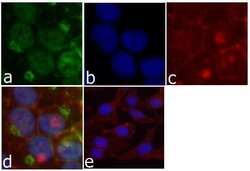
- Experimental details
- Immunofluorescent analysis of Beta-Catenin was done on 70% confluent log phase HeLa cells. The cells were fixed with 4% paraformaldehyde for 15 minutes; permeabilized with 0.25% Triton X-100 for 10 minutes followed by blocking with 5% BSA for 1 hour at room temperature. The cells were incubated with Beta-Catenin Mouse Monoclonal Antibody (Product # 13-8400) at 1.5 µg/mL in 1% BSA and incubated for 3 hours at room temperature and then labeled with Alexa Fluor 488 Rabbit Anti-Mouse IgG Secondary Antibody (Product # A-11059) at a dilution of 1:400 for 30 minutes at room temperature (Panel a: green). Nuclei (Panel b: blue) were stained with SlowFade Gold Antifade Mountant with DAPI (Product # S36938). F-actin (Panel c: red) was stained with Alexa Fluor 594 Phalloidin (Product # A12381). Panel d is a merged image showing cytoplasmic localization of Beta-Catenin and panel e is a no primary antibody control. The images were captured at 20X magnification.
- Submitted by
- Invitrogen Antibodies (provider)
- Main image
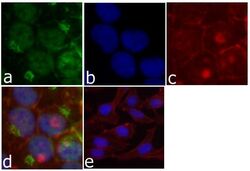
- Experimental details
- Immunofluorescent analysis of Beta-Catenin was done on 70% confluent log phase HeLa cells. The cells were fixed with 4% paraformaldehyde for 15 minutes; permeabilized with 0.25% Triton X-100 for 10 minutes followed by blocking with 5% BSA for 1 hour at room temperature. The cells were incubated with Beta-Catenin Mouse Monoclonal Antibody (Product # 13-8400) at 1.5 µg/mL in 1% BSA and incubated for 3 hours at room temperature and then labeled with Alexa Fluor 488 Rabbit Anti-Mouse IgG Secondary Antibody (Product # A-11059) at a dilution of 1:400 for 30 minutes at room temperature (Panel a: green). Nuclei (Panel b: blue) were stained with SlowFade Gold Antifade Mountant with DAPI (Product # S36938). F-actin (Panel c: red) was stained with Alexa Fluor 594 Phalloidin (Product # A12381). Panel d is a merged image showing cytoplasmic localization of Beta-Catenin and panel e is a no primary antibody control. The images were captured at 20X magnification.
Supportive validation
- Submitted by
- Invitrogen Antibodies (provider)
- Main image
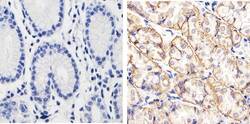
- Experimental details
- Immunohistochemistry analysis of Beta catenin showing staining in the membrane of paraffin-embedded human stomach tissue (right) compared to a negative control without primary antibody (left). To expose target proteins, antigen retrieval was performed using 10mM sodium citrate (pH 6.0), microwaved for 8-15 min. Following antigen retrieval, tissues were blocked in 3% H2O2-methanol for 15 min at room temperature, washed with ddH2O and PBS, and then probed with a Beta catenin monoclonal antibody (Product # 13-8400) diluted in 3% BSA-PBS at a dilution of 1:20 overnight at 4°C in a humidified chamber. Tissues were washed extensively in PBST and detection was performed using an HRP-conjugated secondary antibody followed by colorimetric detection using a DAB kit. Tissues were counterstained with hematoxylin and dehydrated with ethanol and xylene to prep for mounting.
- Submitted by
- Invitrogen Antibodies (provider)
- Main image
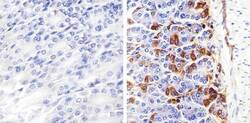
- Experimental details
- Immunohistochemistry analysis of Beta catenin showing staining in the cytoplasm and membrane of paraffin-embedded mouse stomach tissue (right) compared to a negative control without primary antibody (left). To expose target proteins, antigen retrieval was performed using 10mM sodium citrate (pH 6.0), microwaved for 8-15 min. Following antigen retrieval, tissues were blocked in 3% H2O2-methanol for 15 min at room temperature, washed with ddH2O and PBS, and then probed with a Beta catenin monoclonal antibody (Product # 13-8400) diluted in 3% BSA-PBS at a dilution of 1:100 overnight at 4°C in a humidified chamber. Tissues were washed extensively in PBST and detection was performed using an HRP-conjugated secondary antibody followed by colorimetric detection using a DAB kit. Tissues were counterstained with hematoxylin and dehydrated with ethanol and xylene to prep for mounting.
- Submitted by
- Invitrogen Antibodies (provider)
- Main image
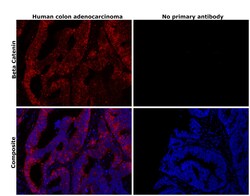
- Experimental details
- Immunohistochemical analysis of Beta Catenin was performed using formalin-fixed paraffin-embedded human colon adenocarcinoma tissue sections. To expose the target protein, heat-induced epitope retrieval was performed on de-paraffinized sections using eBioscience™ IHC Antigen Retrieval Solution - High pH (10X) (Product # 00-4956-58) diluted to 1X solution in water in a decloaking chamber at 110 degree Celsius for 15 minutes. Following antigen retrieval, the sections were blocked with 3% H2O2 for 1 hour at room temperature followed by 2% normal goat serum in 1X PBS for 45 minutes at room temperature and then probed with or without beta Catenin Monoclonal Antibody (CAT-5H10) (Product # 13-8400) at 1:500 dilution in 0.1% normal goat serum overnight at 4 degree Celsius in a humidified chamber. Detection was performed using Alexa Fluor™ 647 Tyramide SuperBoost™ Kit, goat anti-mouse IgG (Product # B40916). Nuclei were stained with DAPI (Product # D1306) and the sections were mounted using ProLong™ Glass Antifade Mountant (Product # P36984). The images were captured on EVOS™ M7000 Imaging System (Product # AMF7000) at 20X magnification and externally deconvoluted.
- Submitted by
- Invitrogen Antibodies (provider)
- Main image
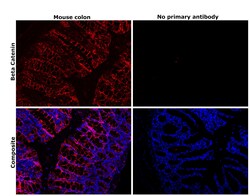
- Experimental details
- Immunohistochemical analysis of Beta Catenin was performed using formalin-fixed paraffin-embedded mouse colon tissue sections. To expose the target protein, heat-induced epitope retrieval was performed on de-paraffinized sections using eBioscience™ IHC Antigen Retrieval Solution - High pH (10X) (Product # 00-4956-58) diluted to 1X solution in water in a decloaking chamber at 110 degree Celsius for 15 minutes. Following antigen retrieval, the sections were blocked with 3% H2O2 for 1 hour at room temperature followed by 2% normal goat serum in 1X PBS for 45 minutes at room temperature and then probed with or without beta Catenin Monoclonal Antibody (CAT-5H10) (Product # 13-8400) at 1:500 dilution in 0.1% normal goat serum overnight at 4 degree Celsius in a humidified chamber. Detection was performed using Alexa Fluor™ 647 Tyramide SuperBoost™ Kit, goat anti-mouse IgG (Product # B40916). Nuclei were stained with DAPI (Product # D1306) and the sections were mounted using ProLong™ Glass Antifade Mountant (Product # P36984). The images were captured on EVOS™ M7000 Imaging System (Product # AMF7000) at 20X magnification and externally deconvoluted.
- Submitted by
- Invitrogen Antibodies (provider)
- Main image
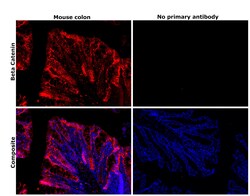
- Experimental details
- Immunohistochemical analysis of Beta Catenin was performed using formalin-fixed paraffin-embedded mouse colon tissue sections. To expose the target protein, heat-induced epitope retrieval was performed on de-paraffinized sections using eBioscience™ IHC Antigen Retrieval Solution - Low pH (10X) (Product # 00-4955-58) diluted to 1X solution in water in a decloaking chamber at 110 degree Celsius for 15 minutes. Following antigen retrieval, the sections were blocked with 3% H2O2 for 1 hour at room temperature followed by 2% normal goat serum in 1X PBS for 45 minutes at room temperature and then probed with or without beta Catenin Monoclonal Antibody (CAT-5H10) (Product # 13-8400) at 1:500 dilution in 0.1% normal goat serum overnight at 4 degree Celsius in a humidified chamber. Detection was performed using Alexa Fluor™ 647 Tyramide SuperBoost™ Kit, goat anti-mouse IgG (Product # B40916). Nuclei were stained with DAPI (Product # D1306) and the sections were mounted using ProLong™ Glass Antifade Mountant (Product # P36984). The images were captured on EVOS™ M7000 Imaging System (Product # AMF7000) at 20X magnification and externally deconvoluted.
- Submitted by
- Invitrogen Antibodies (provider)
- Main image
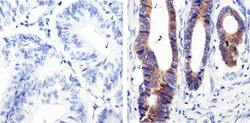
- Experimental details
- Immunohistochemistry analysis of Beta catenin showing staining in the cytoplasm and membrane of paraffin-embedded human colon carcinoma (right) compared to a negative control without primary antibody (left). To expose target proteins, antigen retrieval was performed using 10mM sodium citrate (pH 6.0), microwaved for 8-15 min. Following antigen retrieval, tissues were blocked in 3% H2O2-methanol for 15 min at room temperature, washed with ddH2O and PBS, and then probed with a Beta catenin monoclonal antibody (Product # 13-8400) diluted in 3% BSA-PBS at a dilution of 1:100 overnight at 4°C in a humidified chamber. Tissues were washed extensively in PBST and detection was performed using an HRP-conjugated secondary antibody followed by colorimetric detection using a DAB kit. Tissues were counterstained with hematoxylin and dehydrated with ethanol and xylene to prep for mounting.
- Submitted by
- Invitrogen Antibodies (provider)
- Main image
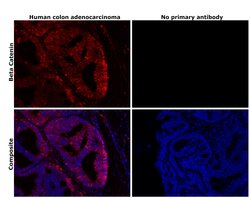
- Experimental details
- Immunohistochemical analysis of Beta Catenin was performed using formalin-fixed paraffin-embedded human colon adenocarcinoma tissue sections. To expose the target protein, heat-induced epitope retrieval was performed on de-paraffinized sections using eBioscience™ IHC Antigen Retrieval Solution - Low pH (10X) (Product # 00-4955-58) diluted to 1X solution in water in a decloaking chamber at 110 degree Celsius for 15 minutes. Following antigen retrieval, the sections were blocked with 3% H2O2 for 1 hour at room temperature followed by 2% normal goat serum in 1X PBS for 45 minutes at room temperature and then probed with or without beta Catenin Monoclonal Antibody (CAT-5H10) (Product # 13-8400) at 1:500 dilution in 0.1% normal goat serum overnight at 4 degree Celsius in a humidified chamber. Detection was performed using Alexa Fluor™ 647 Tyramide SuperBoost™ Kit, goat anti-mouse IgG (Product # B40916). Nuclei were stained with DAPI (Product # D1306) and the sections were mounted using ProLong™ Glass Antifade Mountant (Product # P36984). The images were captured on EVOS™ M7000 Imaging System (Product # AMF7000) at 20X magnification and externally deconvoluted.
- Submitted by
- Invitrogen Antibodies (provider)
- Main image
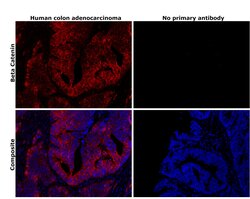
- Experimental details
- Immunohistochemical analysis of Beta Catenin was performed using formalin-fixed paraffin-embedded human colon adenocarcinoma tissue sections. To expose the target protein, heat-induced epitope retrieval was performed on de-paraffinized sections using eBioscience™ IHC Antigen Retrieval Solution - High pH (10X) (Product # 00-4956-58) diluted to 1X solution in water in a decloaking chamber at 110 degree Celsius for 15 minutes. Following antigen retrieval, the sections were blocked with 3% H2O2 for 1 hour at room temperature followed by 2% normal goat serum in 1X PBS for 45 minutes at room temperature and then probed with or without beta Catenin Monoclonal Antibody (CAT-5H10) (Product # 13-8400) at 1:500 dilution in 0.1% normal goat serum overnight at 4 degree Celsius in a humidified chamber. Detection was performed using Alexa Fluor™ 647 Tyramide SuperBoost™ Kit, goat anti-mouse IgG (Product # B40916). Nuclei were stained with DAPI (Product # D1306) and the sections were mounted using ProLong™ Glass Antifade Mountant (Product # P36984). The images were captured on EVOS™ M7000 Imaging System (Product # AMF7000) at 20X magnification and externally deconvoluted.
- Submitted by
- Invitrogen Antibodies (provider)
- Main image
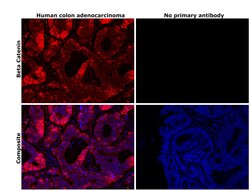
- Experimental details
- Immunohistochemical analysis of Beta Catenin was performed using formalin-fixed paraffin-embedded human colon adenocarcinoma tissue sections. To expose the target protein, heat-induced epitope retrieval was performed on de-paraffinized sections using eBioscience™ IHC Antigen Retrieval Solution - Low pH (10X) (Product # 00-4955-58) diluted to 1X solution in water in a decloaking chamber at 110 degree Celsius for 15 minutes. Following antigen retrieval, the sections were blocked with 3% H2O2 for 1 hour at room temperature followed by 2% normal goat serum in 1X PBS for 45 minutes at room temperature and then probed with or without beta Catenin Monoclonal Antibody (CAT-5H10) (Product # 13-8400) at 1:500 dilution in 0.1% normal goat serum overnight at 4 degree Celsius in a humidified chamber. Detection was performed using Alexa Fluor™ 647 Tyramide SuperBoost™ Kit, goat anti-mouse IgG (Product # B40916). Nuclei were stained with DAPI (Product # D1306) and the sections were mounted using ProLong™ Glass Antifade Mountant (Product # P36984). The images were captured on EVOS™ M7000 Imaging System (Product # AMF7000) at 20X magnification and externally deconvoluted.
Supportive validation
- Submitted by
- Invitrogen Antibodies (provider)
- Main image
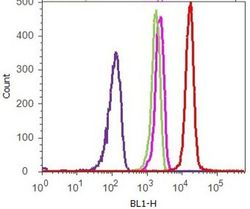
- Experimental details
- Flow cytometry analysis of Beta-Catenin was done on Jurkat cells. Cells were fixed with 70% ethanol for 10 minutes, permeabilized with 0.25% Tritonª X-100 for 20 minutes, and blocked with 5% BSA for 1 hour at room temperature. Cells were labeled with Beta-Catenin Mouse Monoclonal Antibody (138400, red histogram) or with mouse isotype control (pink histogram) at 1-3 µg/million cells in 2.5% BSA. After incubation at room temperature for 2-3 hours, the cells were labeled with Alexa Fluor¨ 488 Rabbit Anti-Mouse Secondary Antibody (A11059) at a dilution of 1:400 for 30 minutes at room temperature. The representative 10,000 cells were acquired and analyzed for each sample using an Attune¨ Acoustic Focusing Cytometer. The purple histogram represents unstained control cells and the green histogram represents no-primary-antibody control.
Supportive validation
- Submitted by
- Invitrogen Antibodies (provider)
- Main image

- Experimental details
- NULL
- Submitted by
- Invitrogen Antibodies (provider)
- Main image
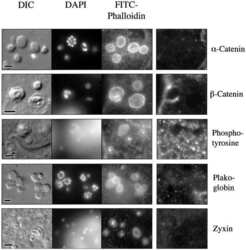
- Experimental details
- NULL
- Submitted by
- Invitrogen Antibodies (provider)
- Main image
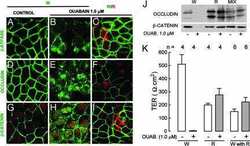
- Experimental details
- NULL
- Submitted by
- Invitrogen Antibodies (provider)
- Main image

- Experimental details
- NULL
- Submitted by
- Invitrogen Antibodies (provider)
- Main image
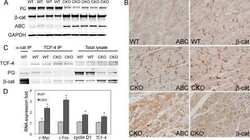
- Experimental details
- NULL
- Submitted by
- Invitrogen Antibodies (provider)
- Main image
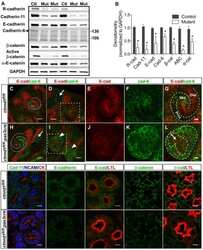
- Experimental details
- NULL
- Submitted by
- Invitrogen Antibodies (provider)
- Main image
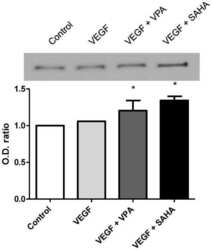
- Experimental details
- NULL
- Submitted by
- Invitrogen Antibodies (provider)
- Main image
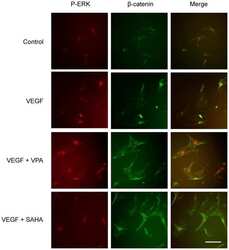
- Experimental details
- NULL
- Submitted by
- Invitrogen Antibodies (provider)
- Main image
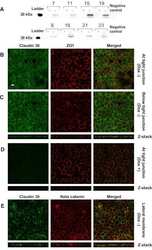
- Experimental details
- NULL
- Submitted by
- Invitrogen Antibodies (provider)
- Main image
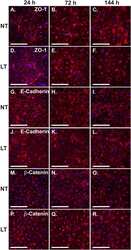
- Experimental details
- NULL
- Submitted by
- Invitrogen Antibodies (provider)
- Main image
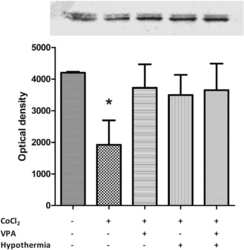
- Experimental details
- NULL
- Submitted by
- Invitrogen Antibodies (provider)
- Main image
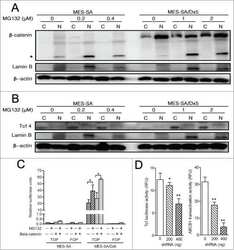
- Experimental details
- NULL
- Submitted by
- Invitrogen Antibodies (provider)
- Main image
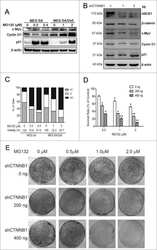
- Experimental details
- NULL
- Submitted by
- Invitrogen Antibodies (provider)
- Main image
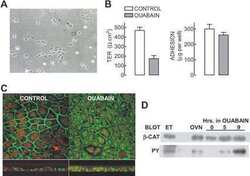
- Experimental details
- NULL
- Submitted by
- Invitrogen Antibodies (provider)
- Main image
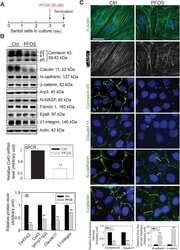
- Experimental details
- NULL
- Submitted by
- Invitrogen Antibodies (provider)
- Main image
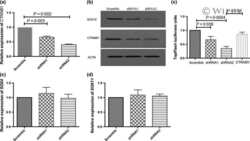
- Experimental details
- NULL
- Submitted by
- Invitrogen Antibodies (provider)
- Main image
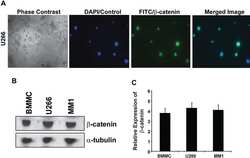
- Experimental details
- NULL
- Submitted by
- Invitrogen Antibodies (provider)
- Main image
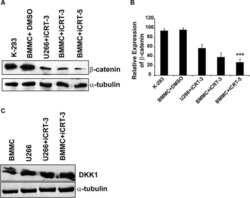
- Experimental details
- NULL
- Submitted by
- Invitrogen Antibodies (provider)
- Main image
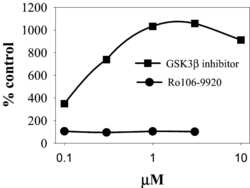
- Experimental details
- NULL
- Submitted by
- Invitrogen Antibodies (provider)
- Main image
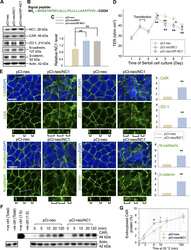
- Experimental details
- NULL
- Submitted by
- Invitrogen Antibodies (provider)
- Main image

- Experimental details
- NULL
- Submitted by
- Invitrogen Antibodies (provider)
- Main image
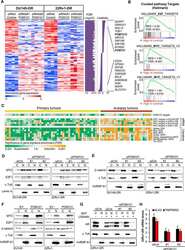
- Experimental details
- NULL
- Submitted by
- Invitrogen Antibodies (provider)
- Main image
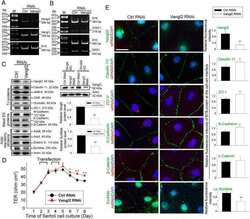
- Experimental details
- NULL
- Submitted by
- Invitrogen Antibodies (provider)
- Main image
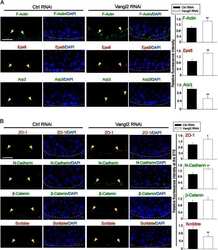
- Experimental details
- NULL
- Submitted by
- Invitrogen Antibodies (provider)
- Main image
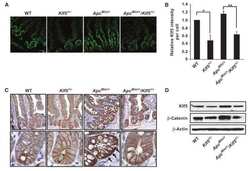
- Experimental details
- NULL
- Submitted by
- Invitrogen Antibodies (provider)
- Main image
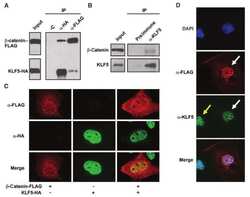
- Experimental details
- NULL
- Submitted by
- Invitrogen Antibodies (provider)
- Main image
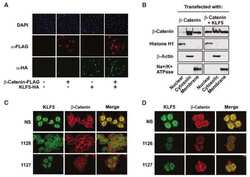
- Experimental details
- NULL
- Submitted by
- Invitrogen Antibodies (provider)
- Main image
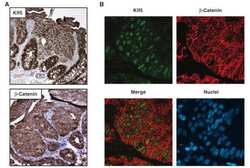
- Experimental details
- NULL
- Submitted by
- Invitrogen Antibodies (provider)
- Main image
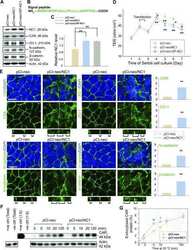
- Experimental details
- NULL
- Submitted by
- Invitrogen Antibodies (provider)
- Main image
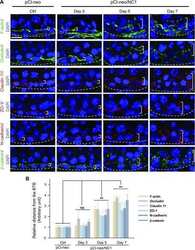
- Experimental details
- NULL
- Submitted by
- Invitrogen Antibodies (provider)
- Main image
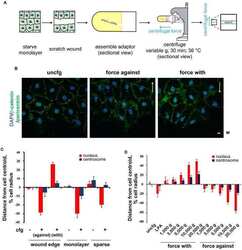
- Experimental details
- NULL
- Submitted by
- Invitrogen Antibodies (provider)
- Main image
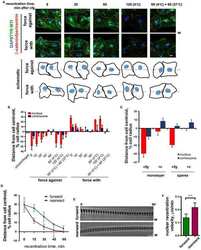
- Experimental details
- NULL
- Submitted by
- Invitrogen Antibodies (provider)
- Main image
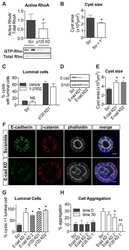
- Experimental details
- NULL
- Submitted by
- Invitrogen Antibodies (provider)
- Main image
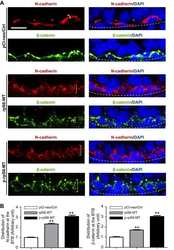
- Experimental details
- NULL
- Submitted by
- Invitrogen Antibodies (provider)
- Main image
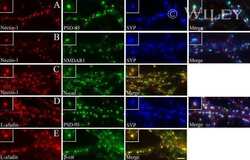
- Experimental details
- NULL
- Submitted by
- Invitrogen Antibodies (provider)
- Main image
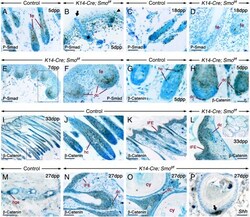
- Experimental details
- Figure 4 Altered Bmp and beta-Catenin Signaling in the K14-Cre; Smo f/f Skin Immunostaining (dark brown) of ventral (A-F and I-L) and dorsal (G, H, and M-P) skin sections from control and mutant mice. (A-F) Phosphorylated Smad 1, 5, and 8 (P-Smad) immunostaining. (B) P-Smad-negative (arrow) and -positive (arrowhead) follicular cells at the skin surface of a mutant. The asterisk in (B) shows a gland. (D-F) Reduced numbers of P-Smad-positive cells in the mutant follicular epithelium (fe). (F) The dermal condensates (dc) associated with the mutant follicles exhibit abnormal nuclear P-Smad staining. (G-O) beta-catenin immunostaining. Nuclear beta-catenin staining in differentiating hair cells (hc) at anagen (G and J) and in the secondary hair germ (hge) at the telogen-to-anagen transition (M) of control follicles. (J) and (K) are high-magnification views of the indicated areas in (I). (H, L, N, and O) Increased beta-catenin staining at cell-cell borders in the interfollicular epidermis (IFE) and in the follicular epithelium (L, N, and O) and decreased staining in the cyst (cy) epithelium. In addition, the mutant follicles are underlain by dc showing nuclear beta-catenin staining. The dashed line in (L) marks the epithelial-mesenchymal junction in a de novo-formed follicle from the IFE. Inset in (L) is a lower magnification view. (P) Shh protein in a newly induced de novo follicle from a pre-existing follicle (arrow). Scale bars: 50 mum (A-D, F-H, J-L, and M-P), 100 mum (E), and 2
- Submitted by
- Invitrogen Antibodies (provider)
- Main image
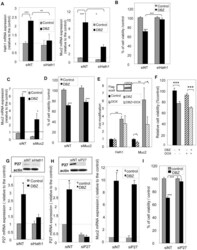
- Experimental details
- Figure 4 Effect of Hath1, MUC2 or P27Kip1 gene silencing on anchorage independent-growth. A,B, C,D,G,H,I- Filter-grown HT29-Cl.27H, treated or not (control) with DBZ for 21 days, were resuspended and plated on polyHEMA-coated wells (nonadherent conditions) for 72 hours culture in the presence of the indicated siRNA target smart pool (NT, non target; Hath1; MUC2 or P27Kip1). A - RT-PCR detection of Hath1 (left) and Muc-2 (right) mRNA in HT29-Cl.27H cells transfected by siRNA (NT, or Hath1): mean expression relative to siNT DMSO after normalization to actin gene expression; Mean +- SEM of 3 experiments; *, P
- Submitted by
- Invitrogen Antibodies (provider)
- Main image
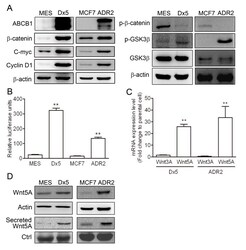
- Experimental details
- Figure 1 The Wnt pathway is upregulated in drug-resistant cancer cells (A) Western blot analysis of ABCB1, beta-catenin, phosphorylated beta-catenin, GSK3beta, phosphorylated GSK3beta, c-Myc and cyclin D1 protein expression levels in MES-SA, MES-SA/Dx5, MCF-7 and MCF-7/ADR2 cells. (B) beta-catenin transactivation activity assayed by TOP assay in both MDR cells. (C) Quantitative real-time PCR assays of Wnt3A and Wnt5A mRNA expression levels in two MDR cells. (D) Western blot analysis of Wnt5A protein levels in the two MDR cancer cells. Data represent mean +- S.D. of three independent experiments. * P
- Submitted by
- Invitrogen Antibodies (provider)
- Main image
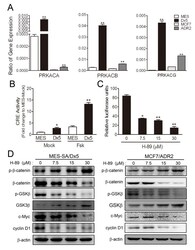
- Experimental details
- Figure 3 Cyclic AMP-dependent protein kinase A pathway is upregulated in two drug-resistant cancer cell lines (A) Real-time RT-PCR analysis of PRKACA, PRKACB and PRKACG mRNA expression in MES-SA, MES-SA/Dx5, MCF7 and MCF7/ADR2 cells. (B) Activities of CRE pathway of 10 muM foskolin-treated MES-SA and MES-SA/Dx5 cells. * P
- Submitted by
- Invitrogen Antibodies (provider)
- Main image
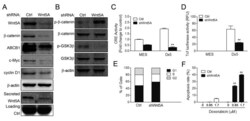
- Experimental details
- Figure 4 CRE and beta-catenin activities and cell viability are reduced in Wnt5A shRNA-knockdown MES-SA/Dx5 cell line (A-B) Western bot analysis of expression levels of (A) Wnt5A, beta-catenin, c-Myc and cyclin D1 and secreted Wnt5A expression levels and (B) beta-catenin, phosphorylated beta-catenin, GSk3,.phosphorylated GSk3beta in shWnt5A transient transfected MES-SA/Dx5 cells. (C) CRE activities and (D) beta-catenin transactivation activities were detected in shWnt5A transient transfected MES-SA and MES-SA/Dx5 cells. (E) Cell cycle assay by PI staining in shWnt5A transient transfected MES-SA/Dx5 cells. (F) Apoptosis rate in doxorubicin-treated Wnt5A-knockdown stably-transfected cells. Data represent mean +- S.D. of three independent experiments. * P
- Submitted by
- Invitrogen Antibodies (provider)
- Main image
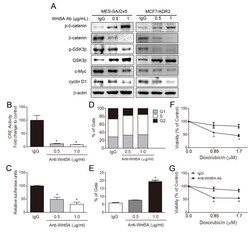
- Experimental details
- Figure 7 Antibody depletion of Wnt5A leads to downregulation of PKA/beta-catenin activities and resensitizes doxorubicin toxicity in MES-SA/Dx5 cells (A) Western blot analysis of beta-catenin, phosphorylated beta-catenin, GSK3beta, phosphorylated GSK3beta, c-Myc, and cyclin D1 protein expression levels in Wnt5A antibody-treated MES-SA/Dx5 and MCF7/ADR2 cells. PKA and beta-catenin activities as monitored by (B) CRE and (C) TOP reporter assays, (D) PI staining in cell cycle analysis and (E) Calcein AM assay of drug pump out ability in Wnt5A antibody treated-MES-SA/Dx5 cell. Values are expressed as the mean +- S.D. (n=3). * P
- Submitted by
- Invitrogen Antibodies (provider)
- Main image
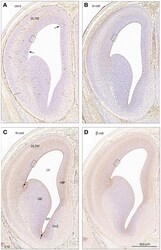
- Experimental details
- Figure 6 Tight and adherens junctional proteins in embryonic mouse brain . An overall view of tight and adherens junctional proteins in the ventricular zone of early mouse CSF-brain interface at low magnification in coronal sections of E16 brain showing immunostaining for claudin-5 (A) , alpha-catenin (B) , N-cadherin (C) , and beta -catenin (D) . Note the differences in distribution of immunopositive staining between different regions of the surface of the ventricular zone with strongest staining of the dorsolateral telencephalic wall (DLTW) and a weak or lacking immunoreactivity of the ganglionic eminence (GE). Arrows in A point to the border of faint claudin-5 reactivity of the ventricular surface of the dorsolateral wall, and in (C) to the increased staining of the dorsolateral and ventral borders of the ganglionic eminence. The boxed areas in (A-D) are shown in higher magnification in Figure 7 . HIP, hippocampus; LV, lateral ventricle; SF, septal fork of the lateral ventricle; SVZ, septal ventricular zone. (A-D) Same magnification, scale bar 500 mum.
- Submitted by
- Invitrogen Antibodies (provider)
- Main image
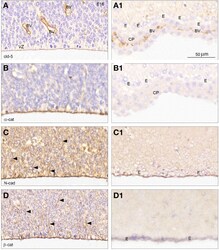
- Experimental details
- Figure 7 Cellular distribution of adherens and tight junctional proteins at the lateral CSF-brain interface . High magnification coronal sections of E16 (A-D) from boxed areas in Figure 6 and of adult (A1-C1) and P20 (D1) forebrain immunostained for claudin-5 (A,A1) , alpha-catenin (B,B1) , N-cadherin (C,C1) , and for beta -catenin (D,D1) . (A) At E16 claudin-5 reactivity is prominent in endothelial cells of blood vessels (BV), but a distinct staining is also present corresponding to the apical-most part of the ventricular zone cells (VZ). (A1) In the adult forebrain ependymal cells (E) show no claudin-5 immunoreactivity in marked contrast to the positively stained endothelial cells of fenestrated blood vessels of the choroid plexus (CP). (B-D) At E16 immunostaining for alpha-catenin (B) , N-cadherin (C) and beta-catenin (D) outlines the apical and apico-lateral most part of the ventricular zone cells,--compare (A) (apical) and (D) (apical and apico-lateral staining). N-cadherin and beta-catenin immunostaining extends into the cytoplasm of the ventricular zone cells ( arrowheads in C,D ). (B1) Immunoreactivity for alpha-catenin is not present in adult forebrain, neither in ependymal cells (E) nor in the choroid plexus (CHP). (C1,D1) The surface of the ependymal cells (E) is strongly stained for N-cadherin but only little reactivity is observed after staining for beta-catenin in the adult forebrain and virtually no reactivity is observed in the subependymal zone. Same magnific
- Submitted by
- Invitrogen Antibodies (provider)
- Main image
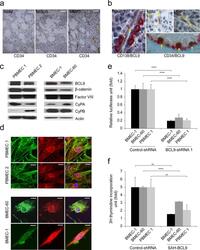
- Experimental details
- Figure 1 Analysis of BCL9 expression and canonical Wnt activity in BMECs ( a ) Representative CD34 immunostains in BM biopsies from normal individuals(NBM) (n=20) as well as MGUS (n=20) and MM persons (MMPT) (n=60). Bars: 50mum.( b ) Representative BCL9 immunostains (brown color) in endothelial cells(arrows) in BM biopsies from MM persons (MMPT) or normal bone marrow (NBM) from otherwisehealthy subjects. Selected representative cases are shown. Anti-CD138 staining (red color)is used as a marker of plasma cells on the left panel (arrows). Anti-CD34 staining (redcolor) is used as a marker of endothelial cells (right bottom panel). Bars: 10mum.Immunoblots ( c ) and immunofluorescence ( d ) analysis of BCL9 andbeta-catenin expression in primary endothelial cells derived from BM from two MMpersons (PBMEC 1, PBMEC 1) and two BM endothelial cell lines (BMEC-1, BMEC-60). Noteco-expression of BCL9 (Red color) and beta-catenin (Greed color) by immunoblotting andby nuclear co-localization immunofluorescence. Factor VIII is used as marker ofendothelial cells in immunoblots. Bars: 5mum. ( e ) Wnt reporter activityof BMEC-1, BMEC-60 and PBMEC 1 cells lentivirally transduced with BCL9-shRNA compared withcells lentivirally transduced with scrambled shRNAs (Control-shRNA). ( f )Proliferation of BMEC-1, BMEC-60 and PBMEC 1 cells treated with medium alone (Vehicle) orin the presence of 10 uM SAH-BCL9. Proliferation and Wnt reporter data was normalizedbased on control or vehicle data. Results ar
- Submitted by
- Invitrogen Antibodies (provider)
- Main image
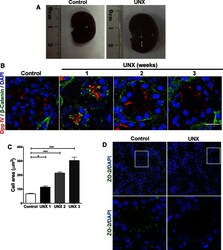
- Experimental details
- FIGURE 6: Uninephrectomy triggered an increase in the size of the remaining kidney. (A) Images of kidneys from 11-wk-old rats. Left, kidney from a control animal; right, kidney from a rat in which the contralateral kidney had been removed 3 wk earlier. (B) Kidney frozen sections from 11-wk-old rats in control condition or that had experimented UNX 1-3 wk earlier. The apical brush border of proximal tubules is stained with specific antibodies against Dpp IV and the basolateral surface with anti-beta-catenin. (C) Quantification of the area of proximal tubule cells from kidneys of 11-wk-old rats (control) or that had experimented UNX 1-3 wk earlier. Area analysis was done using ImageJ on confocal images of frozen kidney sections stained with Dpp IV and anti-beta-catenin. A minimum of 53 cells was evaluated for each condition. Statistical analysis with one-way ANOVA, followed by Dunnett's test; * p < 0.05, *** p < 0.001. (D) ZO-2 expression is lost in the remaining kidneys of rats subjected to UNX. Frozen sections of kidneys from 11-wk-old rats that had been subjected or not to UNX 3 wk earlier were processed for immunofluorescence with an antibody against ZO-2, and the nuclei were stained with DAPI.
- Submitted by
- Invitrogen Antibodies (provider)
- Main image
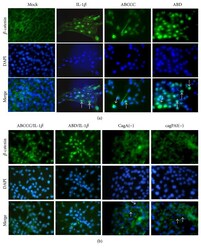
- Experimental details
- Figure 1 H. pylori CagA and IL-1 beta induce beta -catenin nuclear translocation. (a) MCF-10A cells were infected with CagA positive strains (ABCCC or ABD) or stimulated with IL-1 beta . (b) MCF-10A cells were infected with CagA positive strains and stimulated with IL-1 beta or single infected with CagA negative variants CagA(-) and cagPAI(-). Immunofluorescence images show beta -catenin (green) and nuclei (DAPI, blue). Arrows indicate nuclear staining (a) and membrane staining (b) of beta -catenin. Figures are representative of three independent experiments performed in duplicate or triplicate.
- Submitted by
- Invitrogen Antibodies (provider)
- Main image
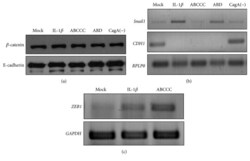
- Experimental details
- Figure 3 Nuclear translocation of beta -catenin correlates with increased expression of ZEB1 and Snail1 . (a) Immunoblotting of whole cell lysates of infected or IL-1 beta -stimulated cells with anti- beta -catenin and anti-E-cadherin antibodies. The relative expression of (b) Snail1 and CDH1 and (c) ZEB1 genes was determined by semiquantitative RT-PCR. Expression of housekeeping genes RPLP0 and GAPDH was used as internal control. Figures are representative of three independent experiments performed in duplicate or triplicate. Figures are representative of three independent experiments performed in duplicate or triplicate.
- Submitted by
- Invitrogen Antibodies (provider)
- Main image
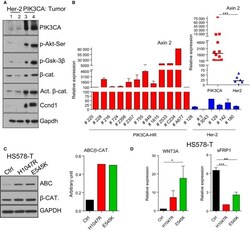
- Experimental details
- Figure 2 Wnt/beta-catenin pathway is activated in PIK 3 CA -H1047R tumors. (A) Western blot analysis of mammary tumors from Her2/neu-overexpressing and PIK 3 CA -H1047R transgenic mice. (B) Quantitative RT - PCR of Axin 2 expression in PIK 3 CA -H1047R ( PIK 3 CA - HR )-mutant and Her-2 mammary tumors. The mean (+- SEM ) of mRNA in each tumor in triplicate is shown. Mann-Whitney U -test was performed, and the median of mRNA levels for all tumors is shown on the top right. RPL 19 was used as housekeeping. (C) Western blot and quantification of activated beta-catenin ( ABC ) and beta-catenin proteins in human breast cancer cell line HS 578T overexpressing either vector control (Ctrl) or PIK 3 CA -H1047R and E545K. GAPDH : loading control. (D) Quantitative RT - PCR of the ligand WNT3A (left) and the pathway negative modulator secreted frizzled-related protein 1 ( sFRP -1, right) mRNA in HS 578T control (Ctrl) or mutant PIK 3 CA . Student's t -test was performed, and the mean (+- SEM ) of the triplicate is shown. * P < 0.05; ** P < 0.01; *** P < 0.001.
- Submitted by
- Invitrogen Antibodies (provider)
- Main image
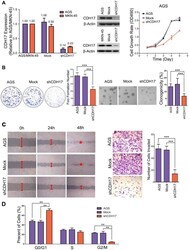
- Experimental details
- Figure 3 Targeting CDH17 reduced the malignant phenotype in gastric carcinoma cells. The expression of CDH17 was suppressed by lentiviral-mediated CDH17 shRNA (shCDH17); cells infected with non-targeted vector (Mock) and parental AGS or MKN-45 cells were used as controls. (A) qRT-PCR(Left) and western blot (Middle) show the mRNA and protein level of CDH17 in different experimental groups after puromycin selection. beta-Actin was used as aloading control. (A) (Right) Growth curves of shCDH17 cells were compared with Mock, AGS cells by XTT assay. (Points, mean of at least three independent experiments; bars, SD). (B) Representative inhibition of foci formation in monolayer culture(Left) and colony formation in soft agar culture(Right) by CDH17 knockdown. Column chart shows quantitative analyses of foci or colonies numbers (columns, mean of at least three independent experiments; bars, SD). (C) (Left) A wound was created on a subconfluent culture of parental AGS, Mock cells and shCDH17 cells, and the rate of wound closure was monitored at 0, 24 and 48 hours. A representative photograph from three independent experiments is shown. Original magnification, x200. (C) (Right) Representative images show the shCDH17, Mock and AGS cells that invaded through the matrigel. The number of invading tumor cells was quantified. Columns, mean of triplicate experiments; bars, SD. Original magnification, x200. (D) Cell cycle analysis by way of flow cytometry. Knockdown CDH17 significantly impaire
- Submitted by
- Invitrogen Antibodies (provider)
- Main image
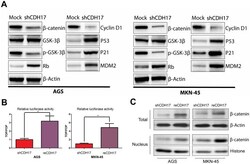
- Experimental details
- Figure 5 CDH17 activates multiple signal transduction pathways. A. Expression of beta-catenin, GSK-3beta, p- GSK-3beta, Rb, Cyclin D1were compared between shCDH17 and Mock both in AGS and MKN-45 cells by Western blot analysis. MDM2, p53 and p21 also were evaluated. beta-Actin was used as a loading control. B. TOPflash/FOPflash reporter assay shows that Wnt signaling re-activated after CDH17 restoration in AGS and MKN-45. (* P
- Submitted by
- Invitrogen Antibodies (provider)
- Main image
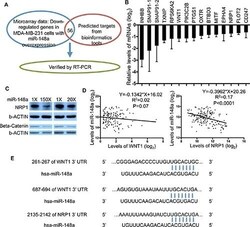
- Experimental details
- Figure 5 Identification of WNT1 and NRP1 as target genes of miR-148a in MDA-MB-231 cells ( A ) Illustration of strategy used to identify target genes of miR-148a. ( B ) qRT-PCR analysis was performed to validate mRNA levels altered by overexpression of miR-148a. ( C ) Protein abundance of WNT1 and NRP1 altered by miR-148a were determined by Western Blot. Two levels of miR-148a overexpression (150x and 20x) were achieved in MDA-MB-231 cells. ( D ) Correlation analysis with linear regression between levels of miR-148a and its target genes was done with GraphPad Prism. The expression levels were extracted from the TCGA database. ( E ) The 3'-UTR of the WNT1 and NRP1 genes contain binding sites for miR-148a seed region according to the TargetScan prediction program.
- Submitted by
- Invitrogen Antibodies (provider)
- Main image
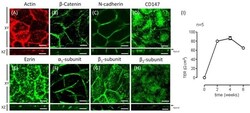
- Experimental details
- Figure 3 Re-morphogenesis of ARPE-19 cells treated with ITS. (A) The photomicrographs show ARPE-19 cells cultured for 4 weeks with ITS and stained for actin with Texas Red-X phalloidin. Note the tight intercellular contact, epithelial-like cellular shape, and predominantly peripheral cortical actin staining. Confocal immunofluorescence images of the same culture conditions showing beta-catenin (B) and N-cadherin (C) at the lateral membrane, CD147 (D) mostly in the apical domain and ezrin (E) in the apical domain. (F) The immunofluorescence image shows immunostaining of the alpha 1 subunit of Na + , K + -ATPase at the lateral membrane and more precisely, as observed in the XZ image, at the cell-cell contacts. (G) The beta 1 subunit is observed at the cell border and at the apical domain; the XZ image confirms both basolateral and apical staining. (H) The beta 2 subunit is observed mainly at the apical domain; the XZ image confirms apical staining. Scale bar: 10 mum. (I) Quantitative analysis of the transepithelial resistance (TER) of ARPE-19 cells during re-morphogenesis is depicted. Note a stable TER of ~80 Omega cm 2 between the second and fourth week in culture.
- Submitted by
- Invitrogen Antibodies (provider)
- Main image
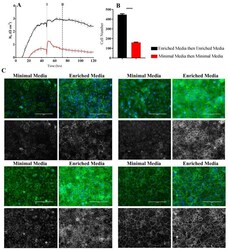
- Experimental details
- Figure 6 Immunocytochemistry of brain endothelial junctional space following growth in either Enriched Media or Minimal Media. Cells were seeded at time 0 h at 20,000 cells per 0.3 cm 2 . ( A ) ECIS resistance and R b measurements over 120 h. Cells were grown in either Enriched Media or Minimal Media from T = 0 h, with media changed at T = 48 h (I). Data shown is the mean +- SD (n = 3 wells) of one independent experiment representative of three experimental repeats; ( B ) Cell number count of Hoechst stained nuclei at time point II, obtained through Image J Software analysis. Data shown is the mean +- SEM (n = 18 wells) of 1 independent experiment representative of 3 experimental repeats; ( C ) The junctional space following growth in either Enriched Media or Minimal Media 72 h post seeding. The time point of fixation corresponds to the second vertical dotted line (II) shown on the ECIS traces. Representative GFP/DAPI and GFP monochrome images for the junctional proteins CD144, ZO-1, beta-catenin, and alpha-catenin are shown. Each panel shows cells grown in Minimal Media on the left and cells grown in Enriched Media on the right. The corresponding Alexa Fluor 488 (GFP) monochrome image is shown below each merged image. Green--junctional protein, blue--nuclei. Scale bar is 200 um. Immunocytochemistry data show one representative image from one independent experiment, which is representative of three experimental repeats. Graphical representations of p values are * p
- Submitted by
- Invitrogen Antibodies (provider)
- Main image
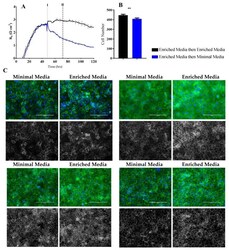
- Experimental details
- Figure 7 Immunocytochemistry of brain endothelial junctional space following growth in either Enriched Media or Minimal Media. Cells were seeded at time 0 h at 20,000 cells per 0.3 cm 2 . ( A ) ECIS resistance and R b measurements over 120 h. Cells were grown in either Enriched Media or Minimal Media from T = 0 h, with media changed at T = 48 h (I). Data shown is the mean +- S.D. (n = 3 wells) of 1 independent experiment representative of 3 experimental repeats; ( B ) Cell number count of Hoechst stained nuclei at time point II, obtained through Image J Software analysis. Data shown is the mean +- SEM (n = 18 wells) of 1 independent experiment representative of 3 experimental repeats; ( C ) The junctional space following growth in either Enriched Media or Minimal Media 72 h post seeding. The time point of fixation corresponds to the second vertical dotted line (II) shown on the ECIS traces. Representative GFP/DAPI and GFP monochrome images for the junctional proteins CD144, ZO-1, beta-catenin and alpha-catenin are shown. Each panel shows cells grown in Minimal Media on the left and cells grown in Enriched Media on the right. The corresponding Alexa Fluor 488 (GFP) monochrome image is shown below each merged image. Green--junctional protein, blue--nuclei. Scale bar is 200 um. Immunocytochemistry data shows 1 representative image from 1 independent experiment, which is representative of 3 experimental repeats. Graphical representations of p values are * p
- Submitted by
- Invitrogen Antibodies (provider)
- Main image
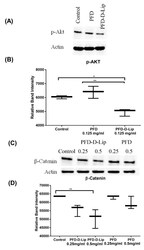
- Experimental details
- Figure 12 ( A ) Western blot representing inhibitory effect of treatments on expression of p-AKT protein in A549 cells. ( B) PFD-D-Lip significantly suppresses p-AKT expression in A549 cells. Cell lysates were prepared following 24-hour treatment of A549 cells with control, PFD and PFD-D-Lip (0.125 mg/mL) and were subjected to western blot analyses using antibodies against p-AKT and actin as a loading control, as indicated. ( C ) Western blot representing inhibitory effect of treatments on expression of beta-catenin protein in A549 cells. ( D ) PFD-D-Lip suppresses beta-catenin expression in A549 cells. Cell lysates were prepared following 72-hour treatment of A549 cells with control, PFD and PFD-D-Lip (0.25 and 0.5 mg/mL) and were subjected to western blot analyses using antibodies against beta-catenin and actin as a loading control, as indicated. The western blot densities were determined and plotted as relative band intensity against treatments. Western blot bands represent representative image of n = 3. Data represent mean +- SD ( n = 3). * p (alpha < 0.05), ** p (alpha < 0.01).
- Submitted by
- Invitrogen Antibodies (provider)
- Main image
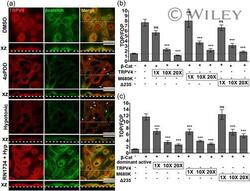
- Experimental details
- 3 Figure TRPV4 affects the nuclear localization of beta-catenin and represses beta-catenin/TCF-mediated transcription. (a) Immunofluorescence of endogenous TRPV4 channel (red) and beta-catenin (green) proteins in scattered MDCK cells in control conditions (DMSO) and after activation of the channel either with the addition of 4alpha-PDD (10 uM) for 30 min or by incubation in a hypotonic solution for 45 min. Lower row, cultures preincubated with RN-1734 (30 uM) 10 min before incubation in a hypotonic solution. (xz) Transversal sections at the level indicated with the discontinuous line. Arrows point to cells with nuclear localization of both TRPV4 and beta-catenin. Scale bars = 25 um. (b) MDCK cells were cotransfected with the reporter plasmid (TOPflash or FOPflash), beta-catenin, and increasing amounts (1x, 10x, and 20x) of TRPV4-Flag channel M680K-Flag or Delta235-Flag. Luciferase activity was measured 24 h after transfection. Data correspond to the means +- SEM of the index TOPflash/FOPflash of at least three independent experiments in quadruplicate. (c) Same that in (b) but using the dominant active beta-catenin. For (b) and (c) *** p < .0001; ns, not significant compared with beta-catenin; as determined by one-way ANOVA followed by Dunnett's post hoc test. 4alpha-PDD, 4alpha-phorbol 12, 13-didecanoate; ANOVA, analysis of variance; DMSO, dimethyl sulfoxide; MDCK, Madin-Darby canine kidney; SEM , standard error of the mean; TRPV4, transient receptor potential vanilloid 4
- Submitted by
- Invitrogen Antibodies (provider)
- Main image
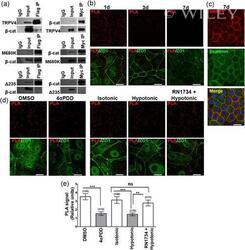
- Experimental details
- 4 Figure The interaction between TRPV4 and beta-catenin is modulated by the channel activity. (a) Coimmunoprecipitation of TRPV4-Flag and Myc-beta-catenin in transiently transfected MDCK cells. Interaction of beta-catenin TRPV4-Flag (up), M608K-Flag (middle), and Delta235-Flag (down). Proteins immunoprecipitated with anti-Flag (Flag IP) or with anti-Myc (Myc IP) antibodies were analyzed by western blot to detect TRPV4 (anti-Flag) and beta-catenin (anti-Myc). IgG, unrelated Ab as negative control; Input, 1% of the protein lysate. Immunoprecipitated proteins are shown in a separate line on the right, although they were analyzed in the same gel with IgG and input controls. For M680K and Delta235 Flag IP lines, a short exposure of the immunoprecipitated channel is compared with a long exposure of the IgG and input lines from the same membrane. (b) Interaction between endogenous TRPV4 and beta-catenin in MDCK cells after one (1d), three (3d), or seven days (7d) in culture after being seeded at 2 x 10 4 cells/cm 2 . PLA signal was detected as red dots by confocal microscopy. Immunodetection of the tight junction marker protein ZO-1 (green) is shown to visualize the cell-cell borders. Scale bars = 25 um. (c) Immunofluorescence of endogenous TRPV4 channel (red) and beta-catenin (green) in MDCK cells after 7 days of culture. Nuclei were stained with Hoechst. Scale bar = 25 um. (d) PLA signal of TRPV4 and beta-catenin interaction in scattered MDCK cells after activation of TRPV4. MDCK
- Submitted by
- Invitrogen Antibodies (provider)
- Main image
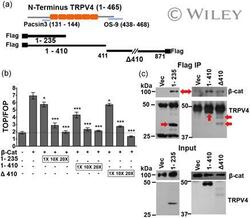
- Experimental details
- 5 Figure TRPV4 contains more than one beta-catenin interaction domain. (a) Diagram showing the N-terminus of TRPV4 (1-465 aa) with the six ankyrin domains as well as the Pacsin 3 and OS-9 interaction domains. The lower part shows different TRPV4 constructs tested for interaction with beta-catenin and the location of the Flag epitope. (b) MDCK cells were cotransfected with the reporter plasmid TOPflash or FOPflash, beta-catenin, and increasing molar amounts of 1-235, 1-410, or Delta410-Flag. Luciferase activity was evaluated 24 h after transfection. Data correspond to the means +- SEM of the index TOPflash/FOPflash of at least three independent experiments in quadruplicate. * p < .05; *** p < .0001 compared with beta-catenin. One-way ANOVA and Dunnett's post hoc test. (c) Coimmunoprecipitation of the peptides of TRPV4 and Myc-beta-catenin transiently transfected in MDCK cells. Interaction of beta-catenin with 1-235, 1-410, and Delta410. Proteins immunoprecipitated with anti-Flag antibody (IP: Flag) were analyzed by western blot to detect beta-catenin (anti-Myc) and TRPV4 peptides (anti-Flag). Cotransfection of the empty vector was used as a negative control. Input, 15 ug of total protein lysate. ANOVA, analysis of variance; MDCK, Madin-Darby canine kidney; SEM , standard error of the mean; TRPV4, transient receptor potential vanilloid 4
- Submitted by
- Invitrogen Antibodies (provider)
- Main image
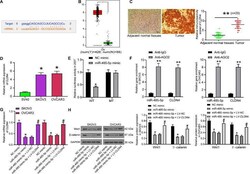
- Experimental details
- Fig. 6 miR-485-5p targets CLDN4 to regulate the Wnt/beta-catenin signaling. A, binding site between miR-485-5p and CLDN4 predicted on Starbase ( http://starbase.sysu.edu.cn/ ); B, miR-485-5p expression profile in OC predicted on GEPIA ( http://gepia.cancer-pku.cn/ ); C, protein expression of CLDN4 in tumor tissues and the paired normal tissues determined by immunohistochemical staining (paired t test,** p < 0.01); D, CLDN4 expression in OC cells and SV40 cells measured by RT-qPCR; E-F, binding relationship between miR-485-5p and CLDN4 validated through a dual luciferase reporter gene assay (E) and an RIP assay (F) (two-way ANOVA,* p < 0.05); G, CLDN4 expression in OC cells after miR-485-5p mimic and LV-CLDN4 transfection determined by RT-qPCR (one-way ANOVA, * p < 0.05 compared to NC mimic, # p < 0.05 compared to miR-485-5p mimic + LV-NC); H, protein levels of Wnt1 and beta-catenin in OC cell lines after miR-485-5p mimic and LV-CLDN4 transfection evaluated using western blot analysis (two-way ANOVA,* p < 0.05 compared to NC mimic, # p < 0.05 compared to miR-485-5p mimic + LV-NC). Data were exhibited as mean +- SD from three independent experiments.
- Submitted by
- Invitrogen Antibodies (provider)
- Main image
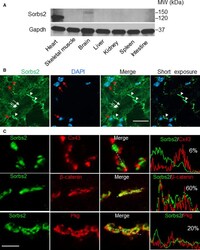
- Experimental details
- Figure 1 Sorbs2 (sorbin and SH3 domain-containing 2) is a cardiac-enriched intercalated disc and desmosome protein in mice. A , Western blot analysis of Sorbs2 protein expression in different mouse tissues. B , Images of immunostaining using an anti-Sorbs2 antibody and counterstained with 4',6-diamidino-2-phenylindole (DAPI) in sectioned wild-type mouse hearts. Arrowheads indicate the intercalated disc. The arrows indicate Z-disc localization. Red arrows indicate the perinucleus. Bar=20 mum. C , Immunostaining and pseudoline analysis of sectioned mouse hearts are shown, indicating that Sorbs2 protein mostly colocalizes with beta-catenin and plakoglobin (Pkg), but less with connexin 43 (Cx43). Bar=2 mum. MW indicates molecular weight.
- Submitted by
- Invitrogen Antibodies (provider)
- Main image
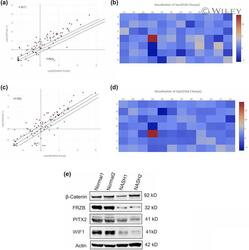
- Experimental details
- 4 FIGURE DEGs between male and female cases in NAFLD using Wnt focusing RT 2 profiler Polymerase chain reaction (PCR) arrays. (a) Scatter plot comparing the normalized average expression of each gene of the ""Wnt targets"" PCR array between the two groups (cases 8 & 5 ""NAFLD"" vs. cases 2 & 3 ""normal"" in female samples). The red and green dot stand for up-regulated and down-regulated genes, respectively, whereas black dots indicate unchanged genes; cut-off = +-1.5. (b) Visualization of log2 (Fold Change). Two groups of differential genes in female samples, intersect and merge gene expression colorimetry maps. Based on the expression levels of the DEGs in each in groups, a log2 is taken. Using systematic clustering (Hierarchical Cluster), the overall clustering result of the sample is obtained. Red indicates higher expression and blue indicates lower expression. (c) Scatter plot comparing the normalized average expression of each gene of the ""Wnt targets"" PCR array between the two groups (cases 6 & 7 ""NAFLD"" vs. cases 1 & 4 ""normal"") in male samples. (d) Visualization of log2 (Fold Change) of gene expression in male samples. (e) Protein expression of beta-catenin, FRZB, PITX2 and WIF1 in normal and NASH samples analyzed by immunoblotting. The samples include Normal 1 (male), Normal 2 (female), NASH 1 (male) and NASH 2 (female). Primary antibodies against beta-catenin, FRZB, PITX2 and WIF1 were used for detection. beta-Actin was used as the loading (reference) control.
- Submitted by
- Invitrogen Antibodies (provider)
- Main image
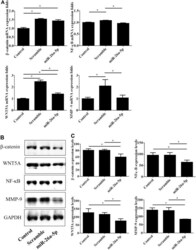
- Experimental details
- Figure 6 miR-26a-5p overexpression modulated expression of Wnt5A/beta-catenin signaling mediators and downstream molecules in UTUC cells. BFTC-909 cells were transfected with miR-26a-5p mimics for 48 h and subjected to detection of mRNA and protein expression by using qPCR ( A ) and western blot ( B) , respectively. GAPDH was used as loading internal control. ( C ) The blotting densitometry of protein levels in BFTC-909 cells. Data are expressed as mean +- SEM (n = 3). *Indicates a P < 0.05 between the indicated groups.
- Submitted by
- Invitrogen Antibodies (provider)
- Main image
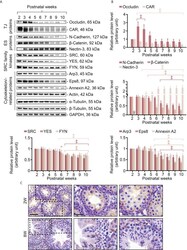
- Experimental details
- Changes in expression levels of FYN and BTB/apical ES-associated proteins in mouse testes during postnatal development. Male mice at 2-10 weeks old were terminated to obtain lysates of testes for immunoblotting experiments (A) . The steady-state levels of TJ proteins (occludin and CAR), ES proteins (N-cadherin, beta-catenin and nectin-3), SRC family kinases (including FYN and another two family members SRC and YES, which are known to regulate BTB and apical ES), and cytoskeletal proteins (including actin and its binding proteins Arp3, Eps8, and annexin A2, as well as alpha- and beta-tubulin) were examined. GAPDH was used as an internal control to ensure the equal protein loading across the gel (~50 ug protein/lane). Histograms (B) summarizing the results of immunoblot analysis in (A) . Each data point was first normalized against its corresponding GAPDH result, then against that of "postnatal week 2" (except for nectin-3, for which "postnatal week 3" was used), which was arbitrarily set to 1. Each bar = mean +- S.D. of three independent experiments. *P
- Submitted by
- Invitrogen Antibodies (provider)
- Main image
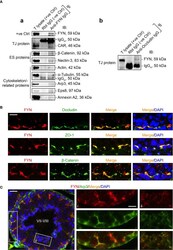
- Experimental details
- Figure 3 FYN is an integral component of the BTB and apical ES as demonstrated by Co-IP and dual-labeled IF assays. (A) Co-IP assays to determine the physical interactions between FYN and selected BTB/apical ES-associated proteins [including TJ proteins CAR (A, a) and occluding (A, b) , basal ES protein beta-catenin, apical ES protein nectin-3, as well as cytoskeletal proteins actin, alpha-tubulin, Arp3, Eps8, and annexin A2] using mouse testis (T) lysates (~800 ug total protein/sample). A positive control (+ve Ctrl) was either testis lysate (30-50 ug protein/lane) without Co-IP, or the immunoprecipitated FYN was detected using its own antibody by immunoblotting (A, a) . For the negative control (-ve Ctrl), anti-FYN IgG was replaced with rabbit (Rbt) IgG. Several immunoblots show the heavy (IgG H ) and light (IgG L ) chains of IgG to better illustrate Co-IP results. (B) Dual-labeled IF staining to corroborate FYN localization at the BTB by its co-distribution with TJ proteins occludin and ZO-1, as well as basal ES protein beta-Catenin in the testis. Scale bar, 10 mum. (C) FYN co-localization with actin binding protein Arp3, a key regulator of branched actin nucleation at the BTB and apical ES, further substantiated its presence at the BTB and apical ES (). The stage of the seminiferous epithelium is indicated in Roman numerals. Scale bar, 16 mum. Boxed areas denoted with i and ii (showing FYN-Arp3 co-localization at the BTB and apical ES, respectively) are enlarged and presen
 Explore
Explore Validate
Validate Learn
Learn